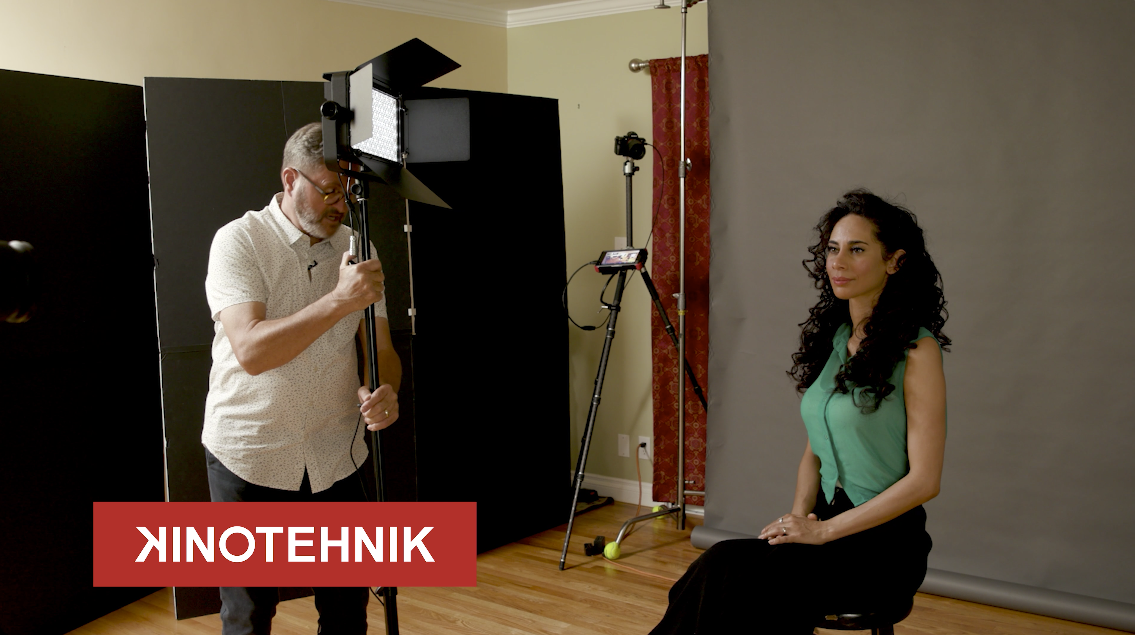Which one do you think is the best still camera ever made? In this hands on, head to head comparison of the Canon R5 vs the Sony a7R iV we run a series of tests. Take a look to see which one we think is the best still camera ever made.
Hi, this is Jay P Morgan and Kenneth Merrill. Today we’ve got Bonnie Genevieve with us and she’s going to help us take a look at the Sony a7R IV and the Canon R5. 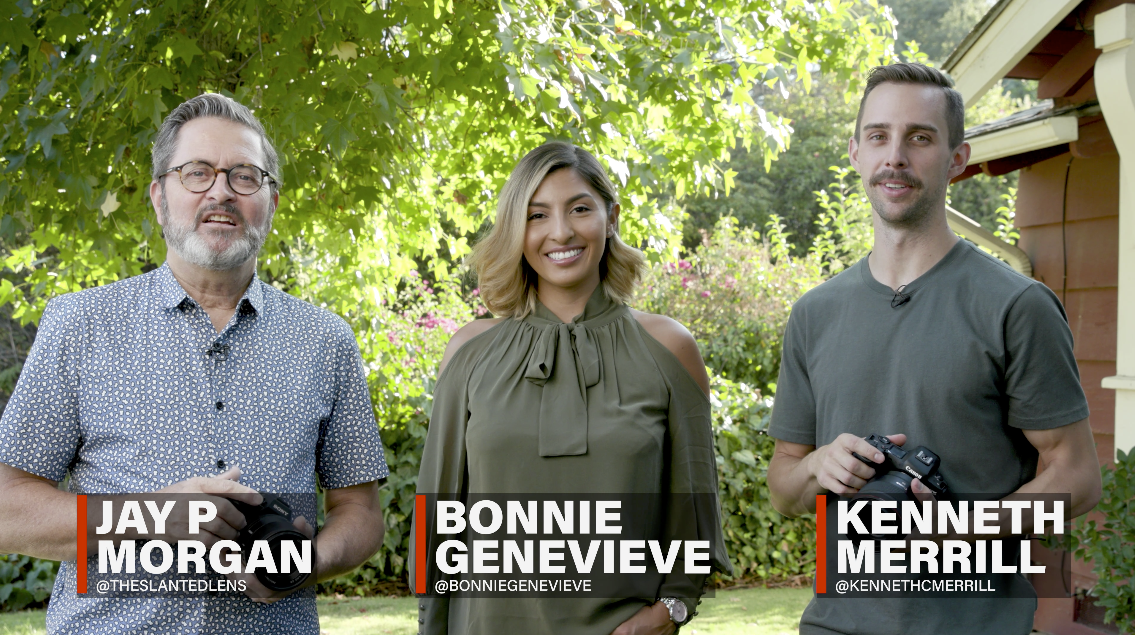 There’s been too much conversation about the video on the the Canon R5. I think Canon blew it. They should have been talking about how amazing this is for stills. I mean 45 megapixels is nothing to sneeze at.
There’s been too much conversation about the video on the the Canon R5. I think Canon blew it. They should have been talking about how amazing this is for stills. I mean 45 megapixels is nothing to sneeze at. 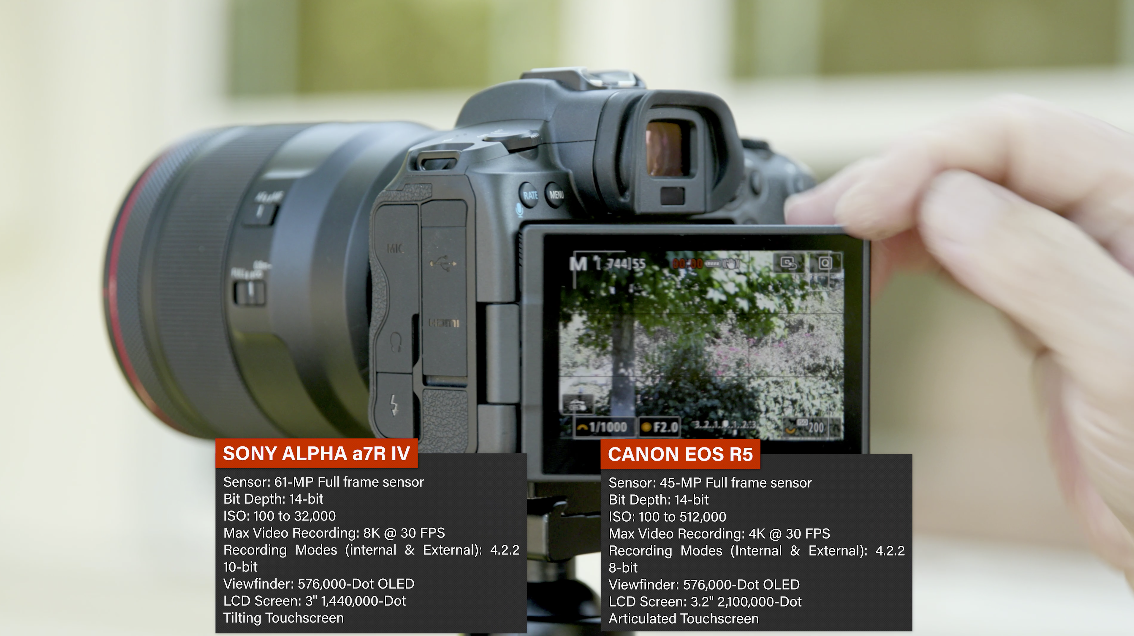 It shoots 12 frames per second. It has over 1000 autofocus points. It’s amazing. It shoots 12 frames per second and up to 180 frames in raw. That’s an incredible camera. It is a 45 megapixel camera versus a 61 megapixel camera effectively. So the Sony a7R4 has a much larger file. It’s a very beautiful image.
It shoots 12 frames per second. It has over 1000 autofocus points. It’s amazing. It shoots 12 frames per second and up to 180 frames in raw. That’s an incredible camera. It is a 45 megapixel camera versus a 61 megapixel camera effectively. So the Sony a7R4 has a much larger file. It’s a very beautiful image. 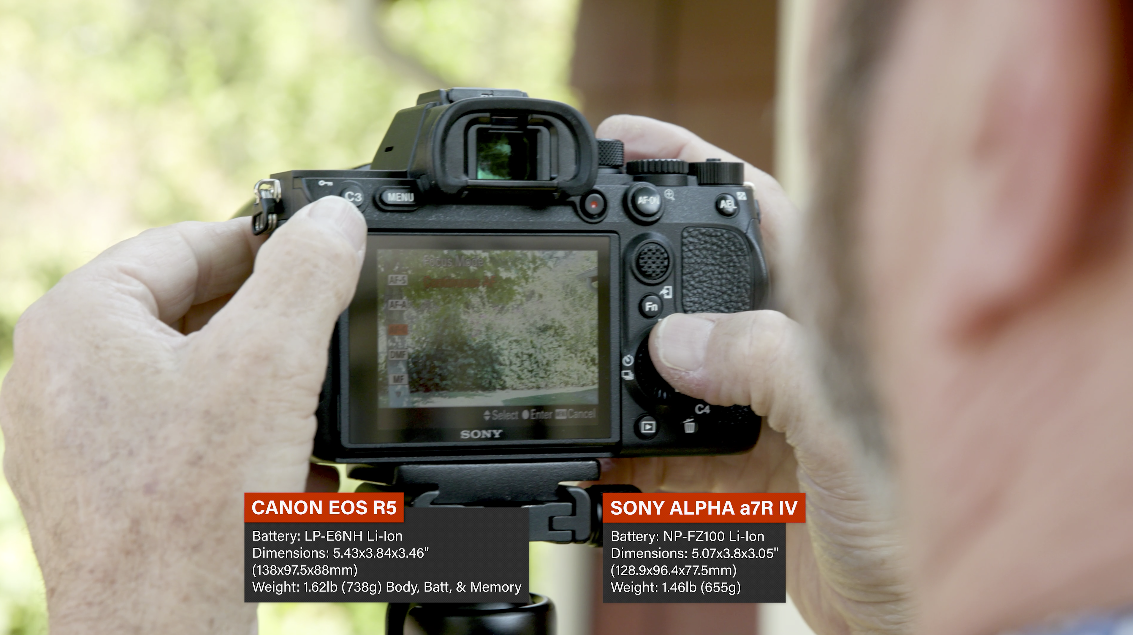 I’ve shot with this camera several times. I think it has an excellent image. I want to look at the autofocus. I want to look at the picture quality. I just want to see how these compare to each other as still cameras. Forget about overheating and all that kind of baloney. Because they don’t have problems when it comes to being still cameras. These two cameras are great cameras to look at with regards to that. Alright, let’s take a look at picture quality and autofocus.
I’ve shot with this camera several times. I think it has an excellent image. I want to look at the autofocus. I want to look at the picture quality. I just want to see how these compare to each other as still cameras. Forget about overheating and all that kind of baloney. Because they don’t have problems when it comes to being still cameras. These two cameras are great cameras to look at with regards to that. Alright, let’s take a look at picture quality and autofocus.
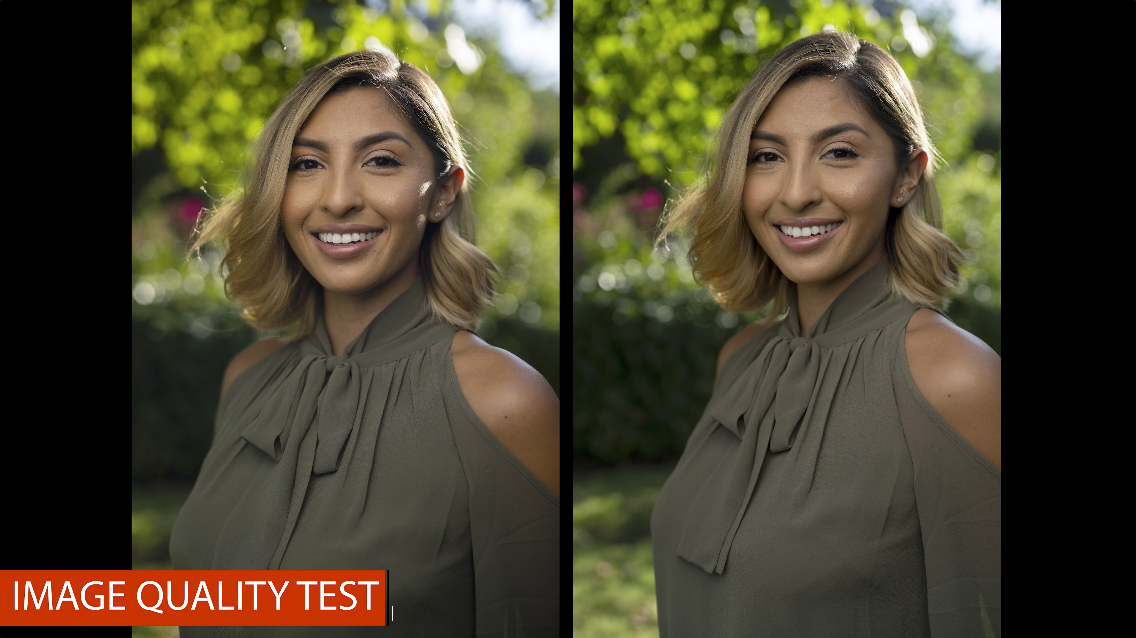
We are doing an image quality test in a lighting situation that’s my absolute favorite. I love it when you have a backlight situation. So you’re looking into the shadows of the background, but you get a nice rim light on her hair. And then we’re going to put a little LED light on her face which looks really nice. So let’s shoot away and just see how these cameras compare. Which picture looks better?
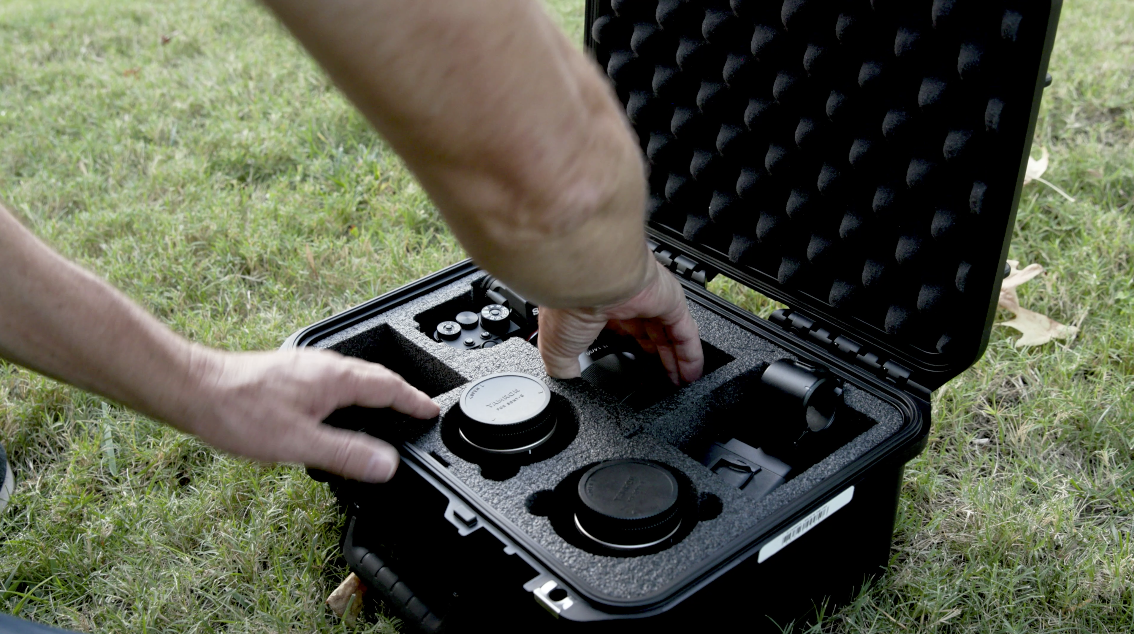 We’re back in the studio and I’m going to break out my Sony from my 1309-6 Sony cut-out case by SKB. These are awesome cases. It comes with a cut out so you put a Sony away in there with a a couple of lenses, either the a7S 3 or you can do the a7R 4 which we’re reviewing here today. So you see a nice cutout in there.
We’re back in the studio and I’m going to break out my Sony from my 1309-6 Sony cut-out case by SKB. These are awesome cases. It comes with a cut out so you put a Sony away in there with a a couple of lenses, either the a7S 3 or you can do the a7R 4 which we’re reviewing here today. So you see a nice cutout in there. 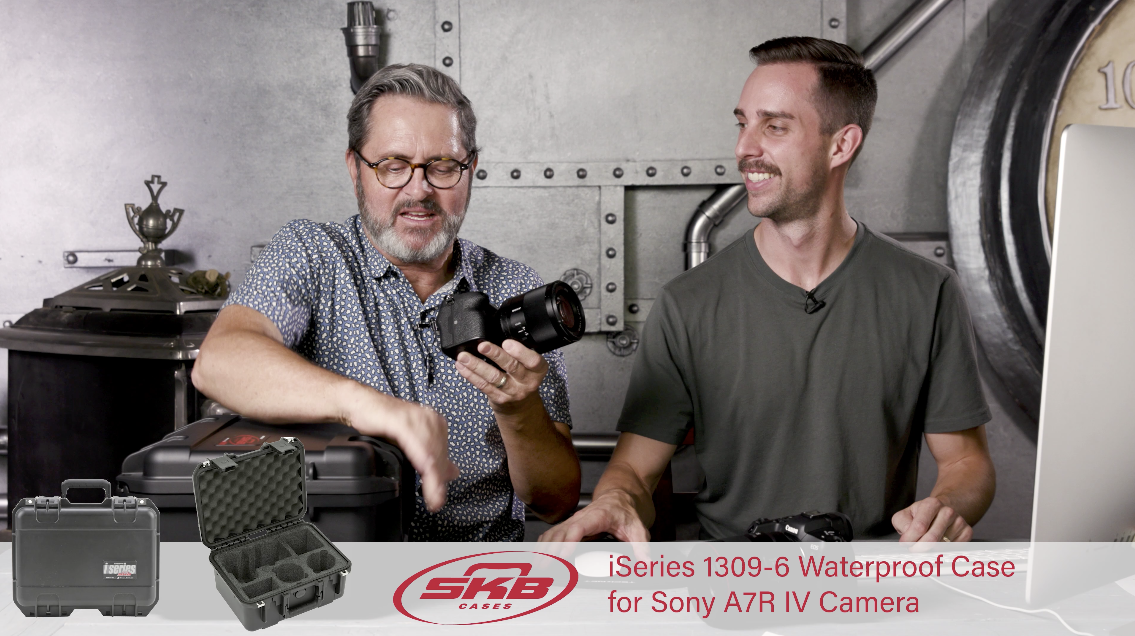 You have room for a couple of lenses. Got my sound module here and some batteries. I do love cases. This is a great one camera kit.
You have room for a couple of lenses. Got my sound module here and some batteries. I do love cases. This is a great one camera kit.
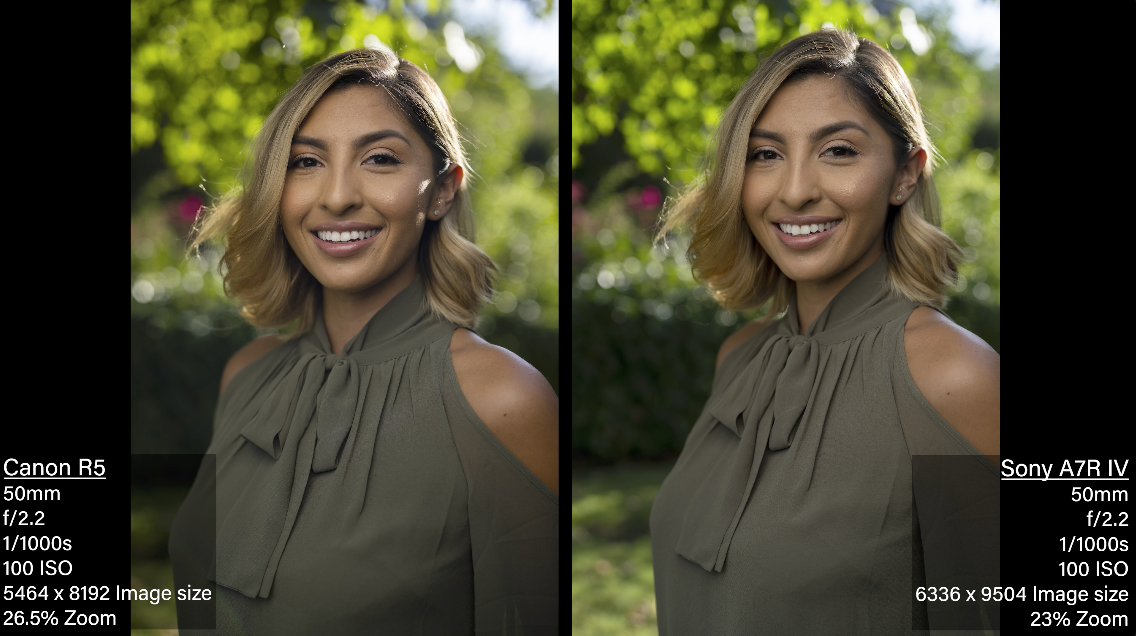 Let’s take a look at our picture quality test. Can you guess which is which? The one on the left is Canon and the one on the right is Sony. I can tell because the color is always a little warmer with Canon and Sony is always a little more muted. Look at her green blouse and look at her skin color. It’s just very obvious.
Let’s take a look at our picture quality test. Can you guess which is which? The one on the left is Canon and the one on the right is Sony. I can tell because the color is always a little warmer with Canon and Sony is always a little more muted. Look at her green blouse and look at her skin color. It’s just very obvious. 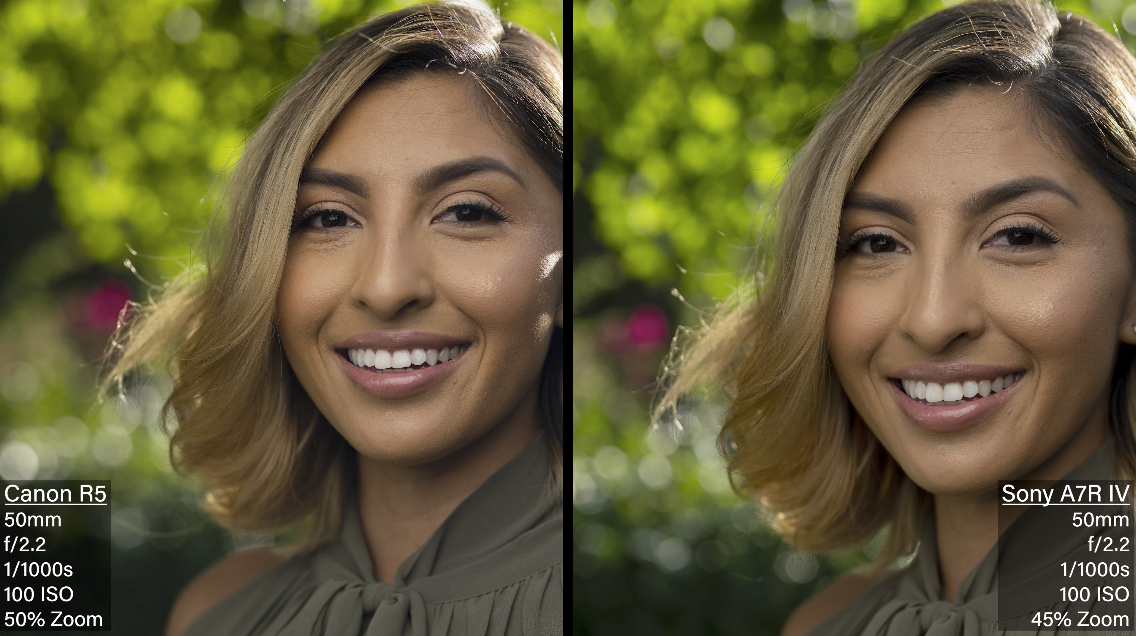 Look at the Reds in that flower in the back. It is interesting though I feel like the red pops just as much in both cameras. So it’s just like there are certain tones that are more muted and certainly more or less true. Look at the greens in the background are popping on the Sony more than they are on the Canon. Canon cameras are more yellowish.
Look at the Reds in that flower in the back. It is interesting though I feel like the red pops just as much in both cameras. So it’s just like there are certain tones that are more muted and certainly more or less true. Look at the greens in the background are popping on the Sony more than they are on the Canon. Canon cameras are more yellowish. 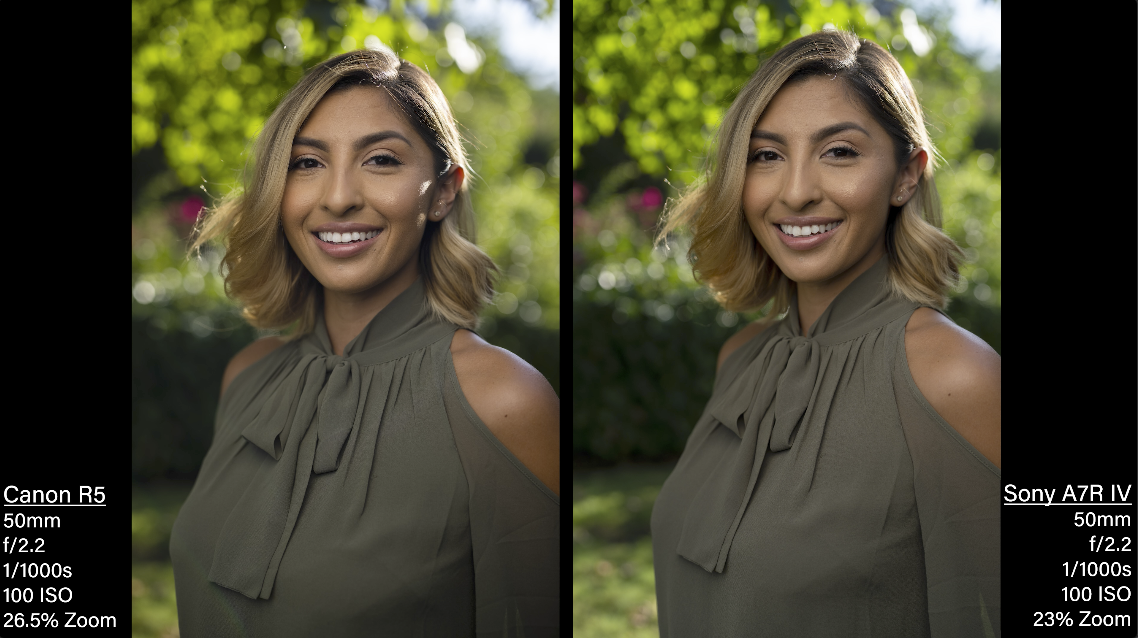 The green of her shirt feels a little more vibrant to me in the Canon versus the Sony. This is probably the most similar I’ve seen a Canon and a Sony look. I didn’t do a ton of adjusting. I will say the Sony was underexposed by about half of a stop. Which we’ve always found that Sony comes in under. But as soon as I pushed that Sony up, they started to look very close to one another. But you can still see a difference there.
The green of her shirt feels a little more vibrant to me in the Canon versus the Sony. This is probably the most similar I’ve seen a Canon and a Sony look. I didn’t do a ton of adjusting. I will say the Sony was underexposed by about half of a stop. Which we’ve always found that Sony comes in under. But as soon as I pushed that Sony up, they started to look very close to one another. But you can still see a difference there.
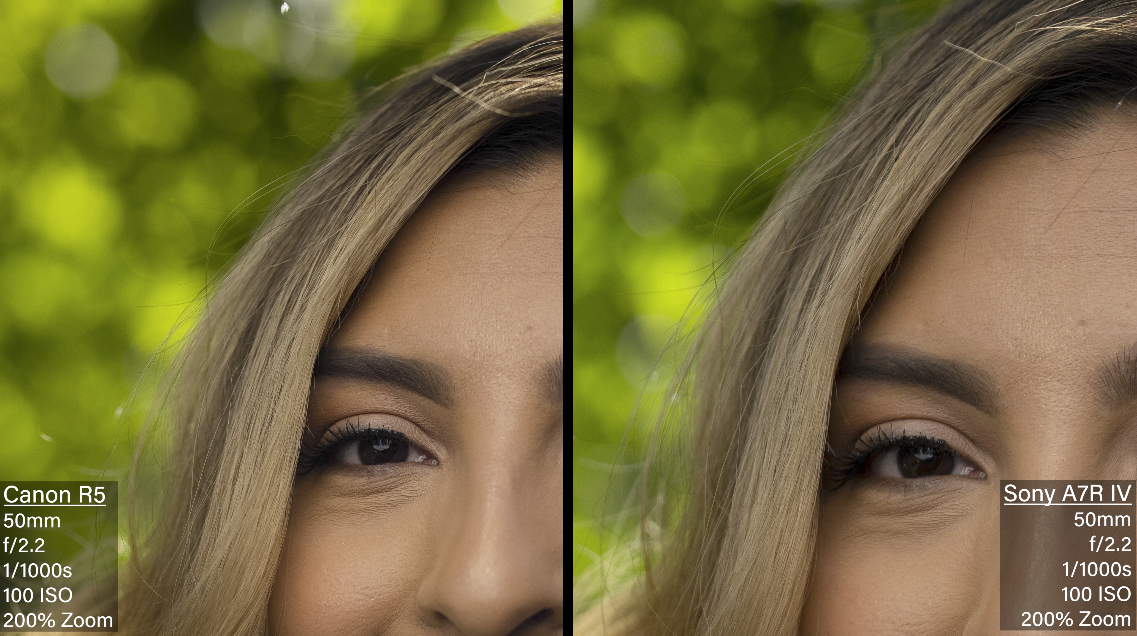 How sharp are they? What’s the sharpness like? Super sharp. You can just go in and see every pore. A model’s nightmare.
How sharp are they? What’s the sharpness like? Super sharp. You can just go in and see every pore. A model’s nightmare.
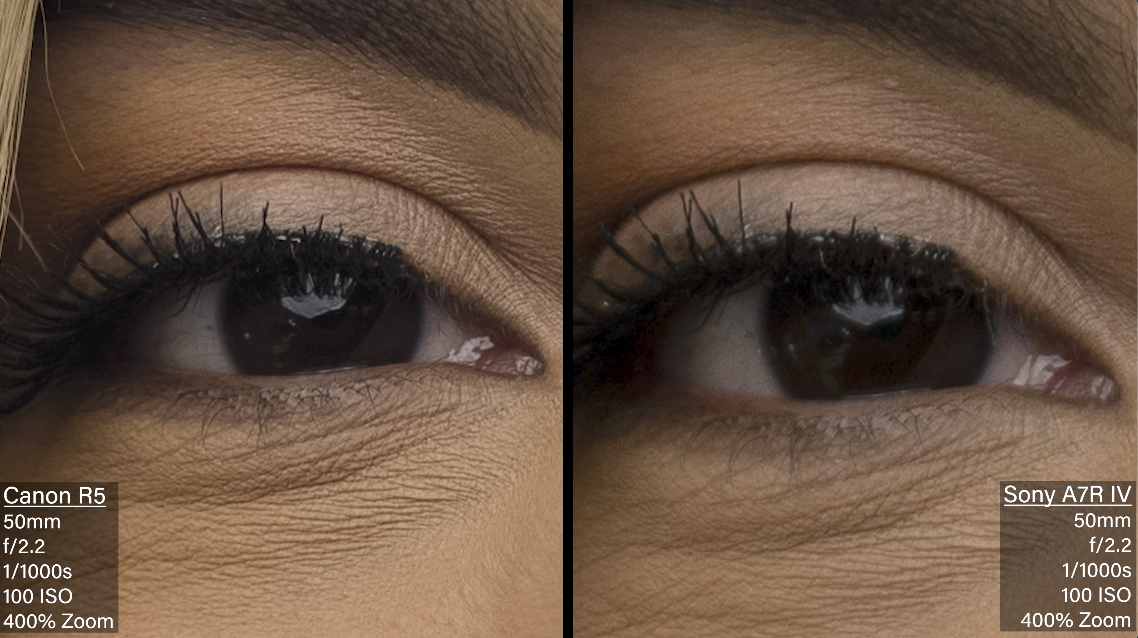
The Sony lens is a little bit softer than the RF lens (Sony Planar T* FE 50mm f/1.4 ZA Lens vs Canon RF 50mm f/1.2L USM Lens). You can kind of see it in her eyelashes. Looking at the picture quality of these two, they’re pretty similar. They both look really nice.
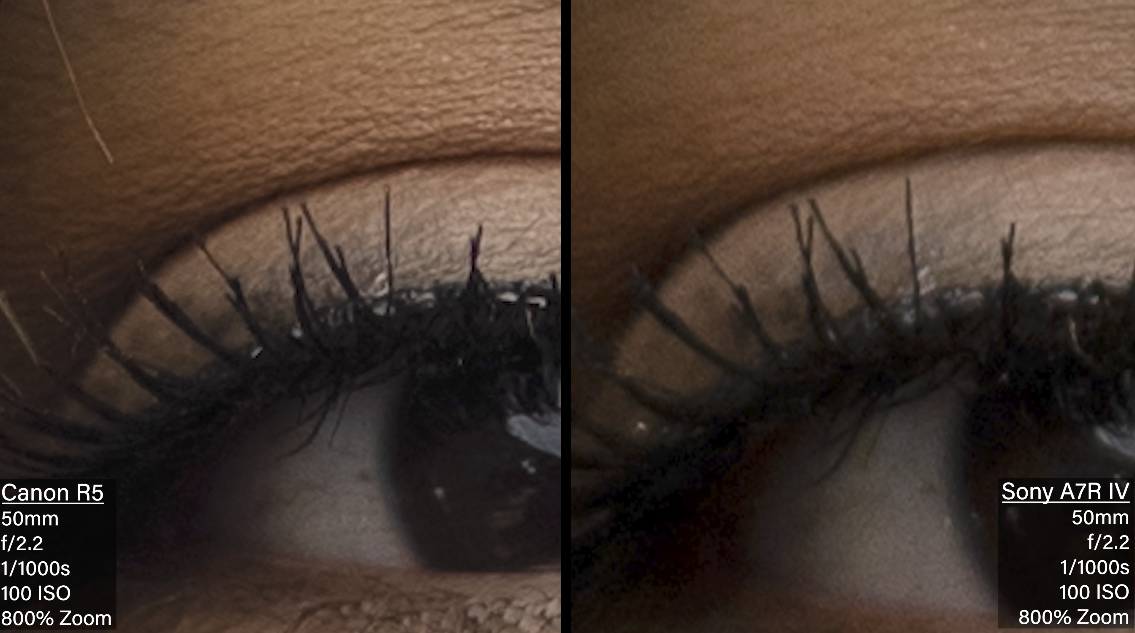
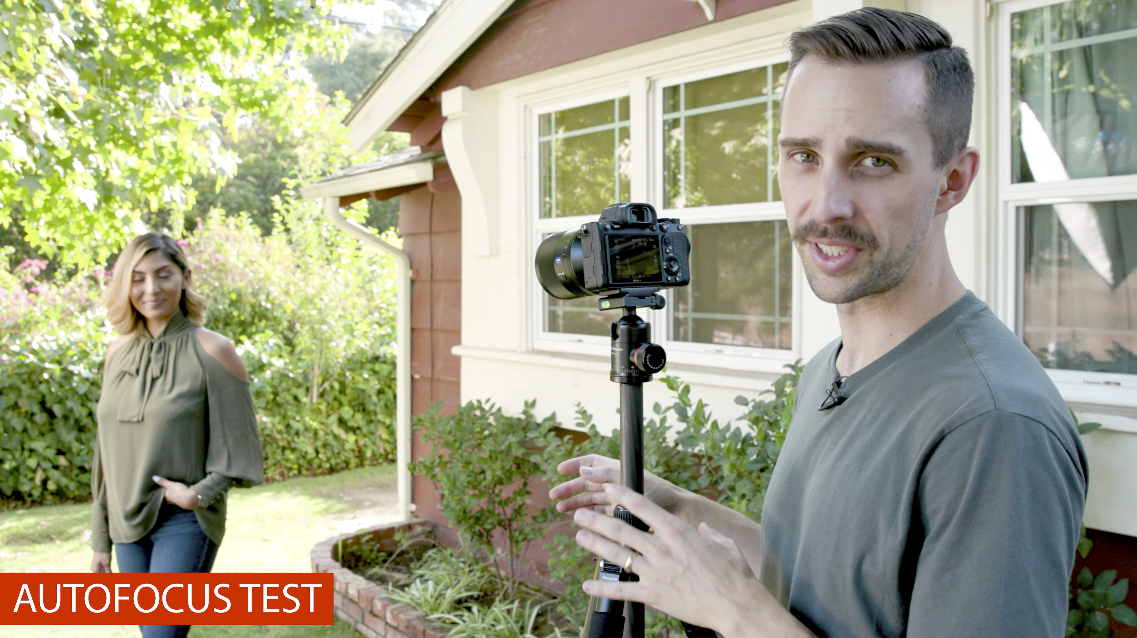 Now we are showing the autofocus test. She’s going to start way back there and just walk straight towards camera into a close up. It works pretty well for what we need it for.
Now we are showing the autofocus test. She’s going to start way back there and just walk straight towards camera into a close up. It works pretty well for what we need it for. 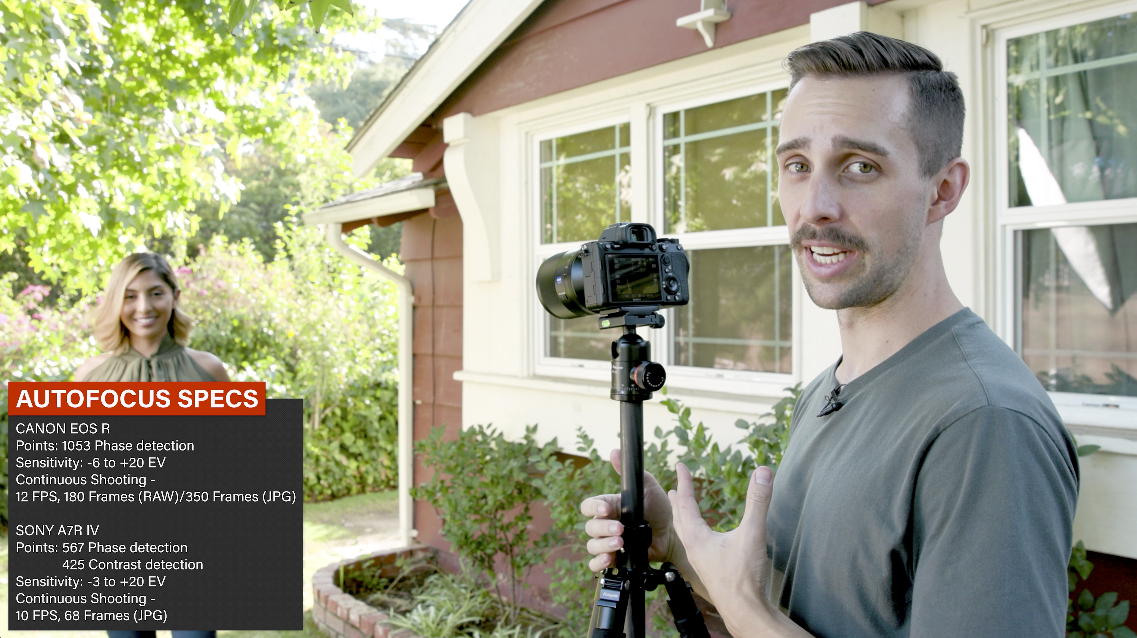 The differences between these two cameras are not insignificant. The Canon has over 1000 phase detect autofocus points. The Sony still only has I think 490 so it’s double for the Canon. We’ll see if that comes into play. When she walks behind the tree. We’ll go to the tree for a second and then the question is how long does it take to pick her up again?
The differences between these two cameras are not insignificant. The Canon has over 1000 phase detect autofocus points. The Sony still only has I think 490 so it’s double for the Canon. We’ll see if that comes into play. When she walks behind the tree. We’ll go to the tree for a second and then the question is how long does it take to pick her up again? 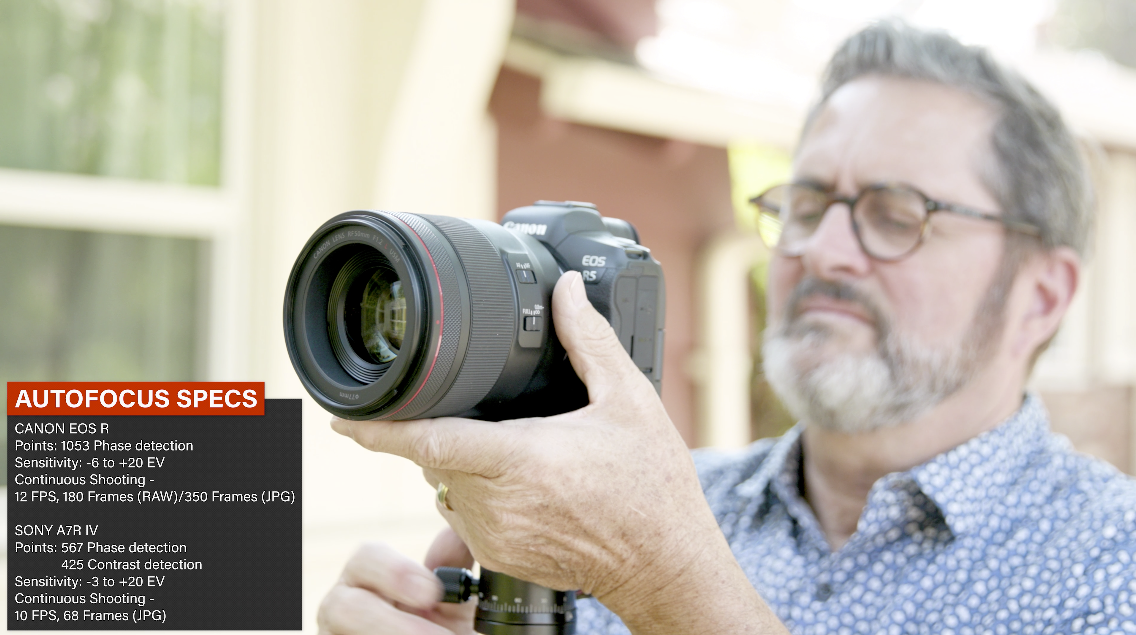 And we found that with the Canon picked her up pretty quickly after that. It wasn’t right away, but as soon as she stepped forward past the tree it snapped back to her.
And we found that with the Canon picked her up pretty quickly after that. It wasn’t right away, but as soon as she stepped forward past the tree it snapped back to her. 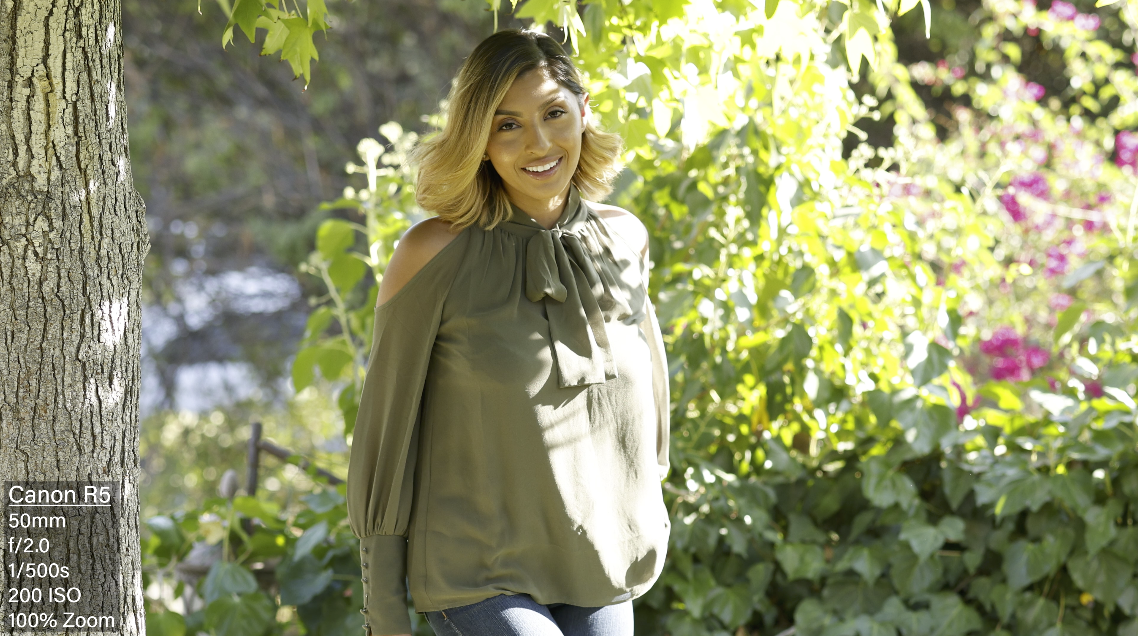 You could see the tree in focus and then it kind of comes back to her.
You could see the tree in focus and then it kind of comes back to her. 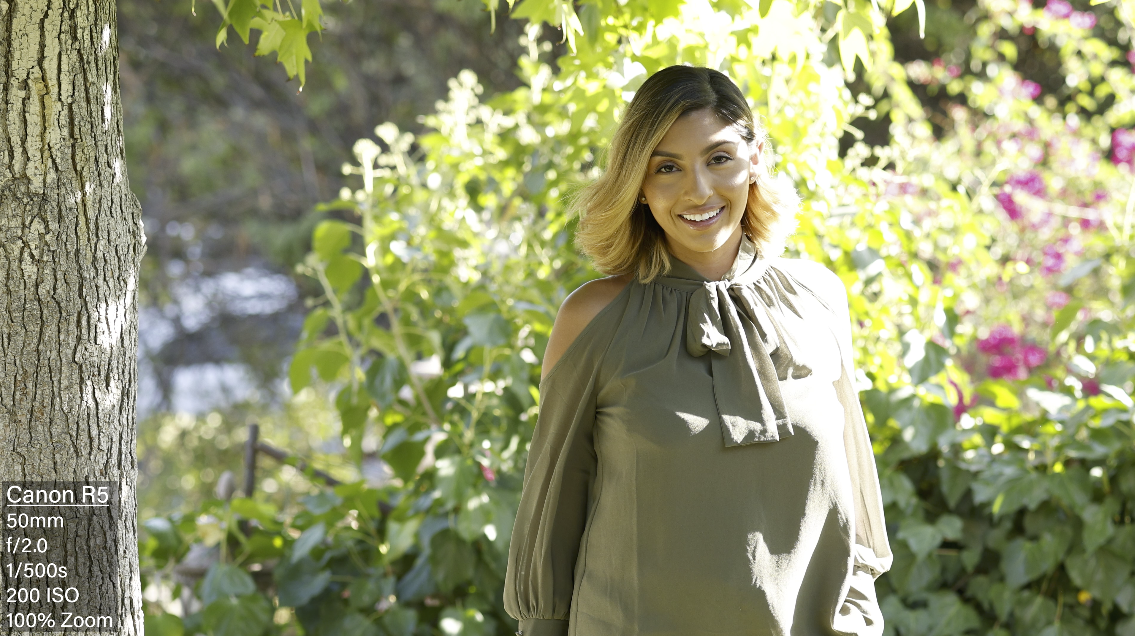 There were a couple photos in between where she was a little soft and with the Sony it was the same thing.
There were a couple photos in between where she was a little soft and with the Sony it was the same thing. 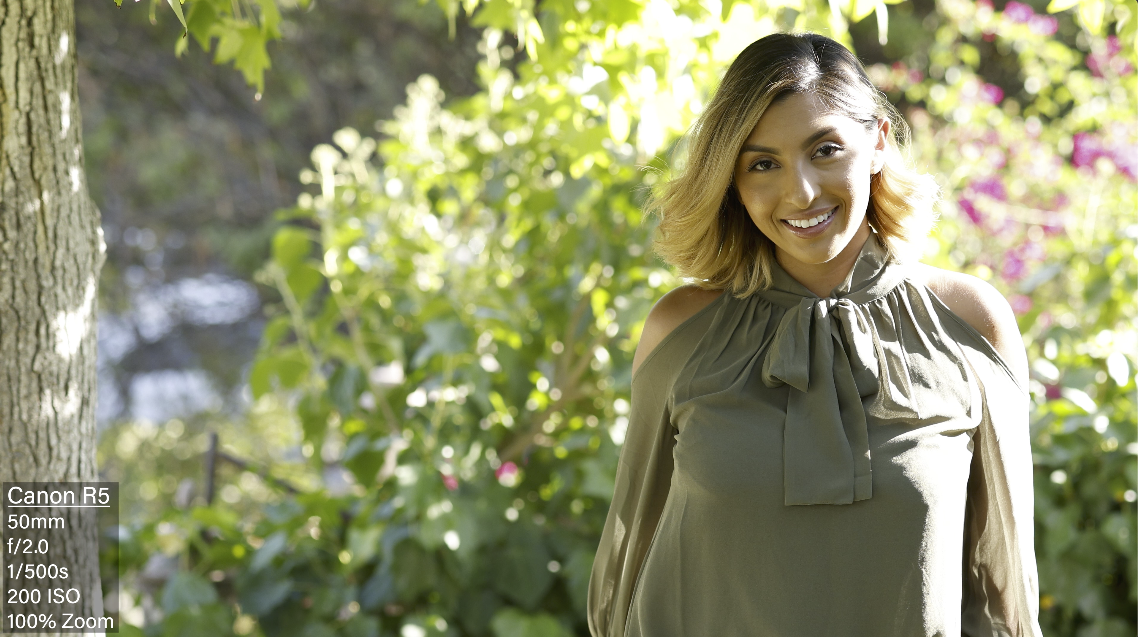 I feel like the Sony took a little bit longer to get to her. And we ran this multiple times and I found that each time it felt like the Sony was catching up with her a little slower than the Canon was.
I feel like the Sony took a little bit longer to get to her. And we ran this multiple times and I found that each time it felt like the Sony was catching up with her a little slower than the Canon was. 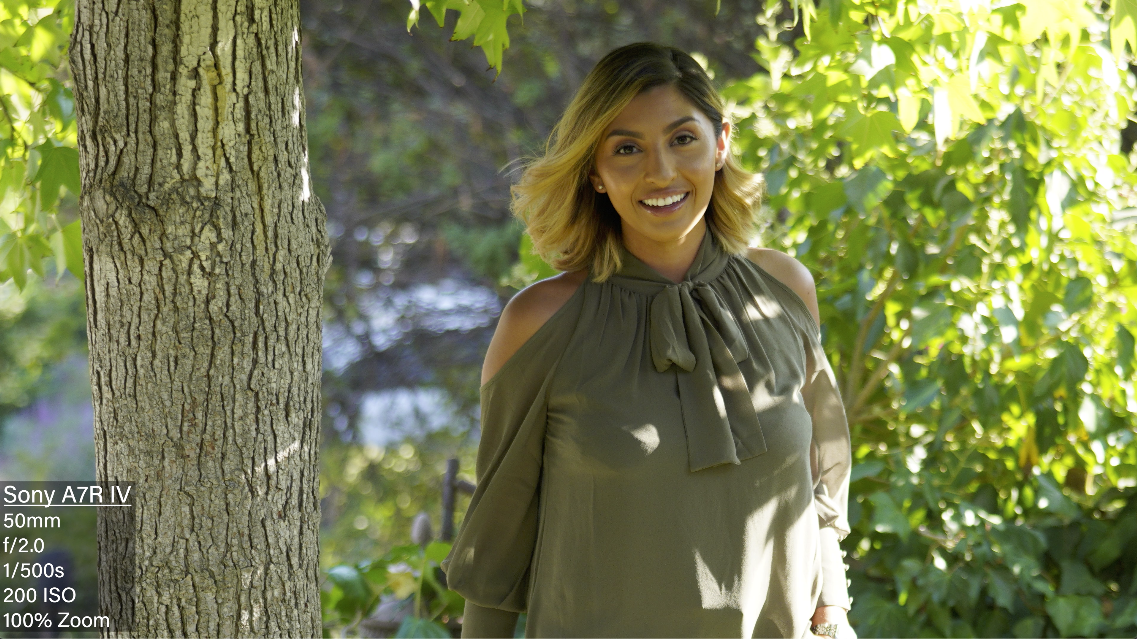 It was stuck on the tree and then came to her when she got a little further ahead. But they both did really well. I would give this a slight edge to the Canon overall.
It was stuck on the tree and then came to her when she got a little further ahead. But they both did really well. I would give this a slight edge to the Canon overall.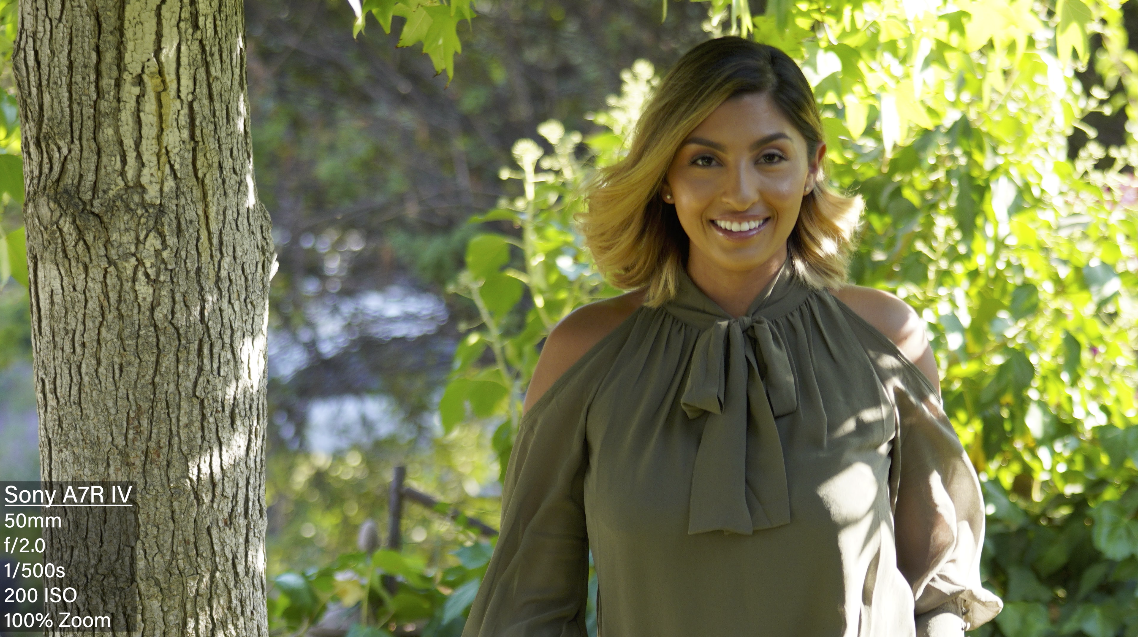
We shot several takes of these and overall it felt like the Canon was a little more responsive with the autofocus. But it’s not I like the Sony was bad by any means. When it’s one out of 10 images that’s a little soft, you know, you’re fine. 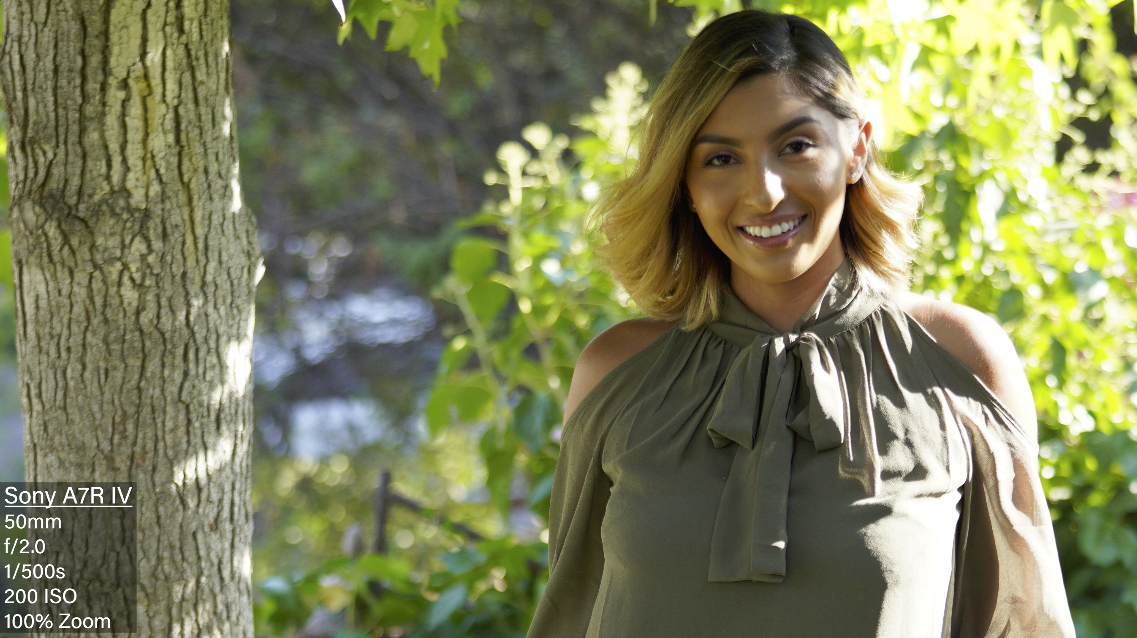 The Sony also has a disadvantage in the buffering. It’s is very slow. But it’s a larger file. It’s moving around a file that’s 50% larger. With the Canon, we would do an autofocus test and then she could go back and we could do it again, right away. But with the Sony, I would have to wait for probably in 60 seconds for it to buffer.
The Sony also has a disadvantage in the buffering. It’s is very slow. But it’s a larger file. It’s moving around a file that’s 50% larger. With the Canon, we would do an autofocus test and then she could go back and we could do it again, right away. But with the Sony, I would have to wait for probably in 60 seconds for it to buffer.
 So let’s do a dynamic range test with the Canon R5 and the Sony a7R 4. We want to see the dynamic range on each of these cameras and how much of the highlight they can hold and how much of the shadow they can hold. And where does the color start to shift? It’s a really important test.
So let’s do a dynamic range test with the Canon R5 and the Sony a7R 4. We want to see the dynamic range on each of these cameras and how much of the highlight they can hold and how much of the shadow they can hold. And where does the color start to shift? It’s a really important test. 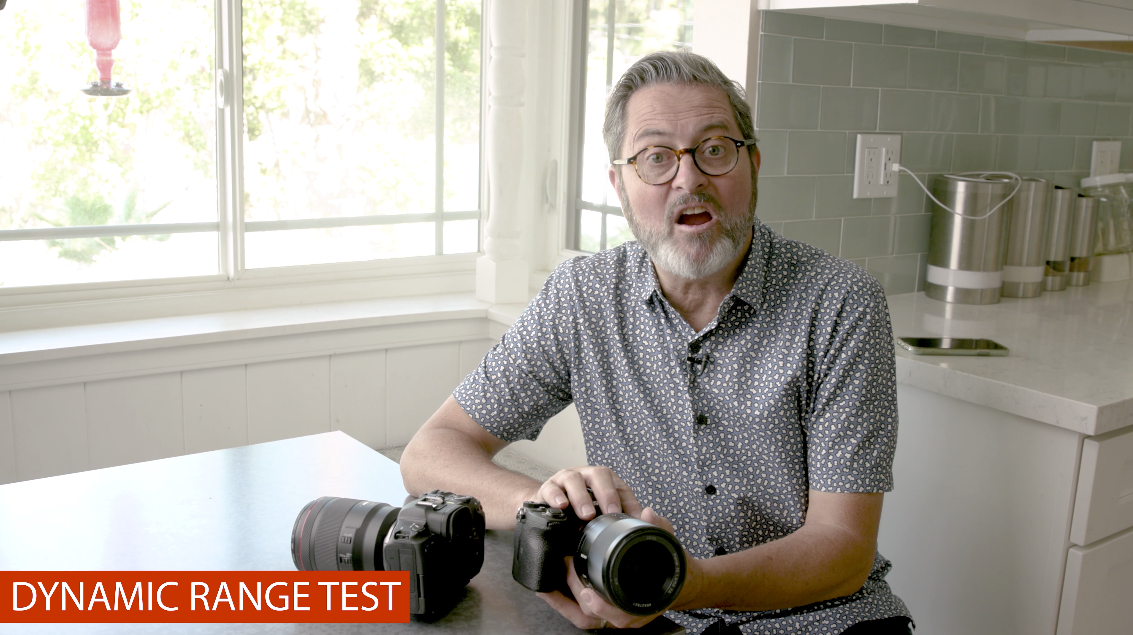 And you might think, why is this so important? Well, because it shows you, if you can be in really heavy light situations, if you can recover the images.
And you might think, why is this so important? Well, because it shows you, if you can be in really heavy light situations, if you can recover the images. 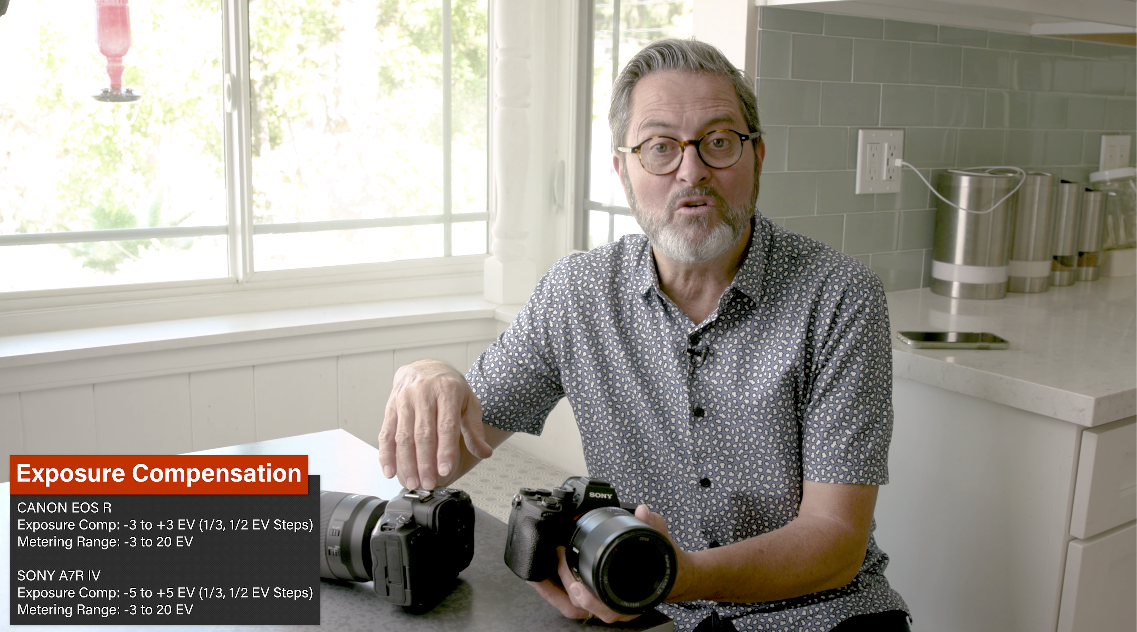 It shows you how the camera is going to handle pushing the boundaries of the dynamic range, and which one is going to help keep the color and keep the highlights and shadows. So let’s take a look at it.
It shows you how the camera is going to handle pushing the boundaries of the dynamic range, and which one is going to help keep the color and keep the highlights and shadows. So let’s take a look at it.
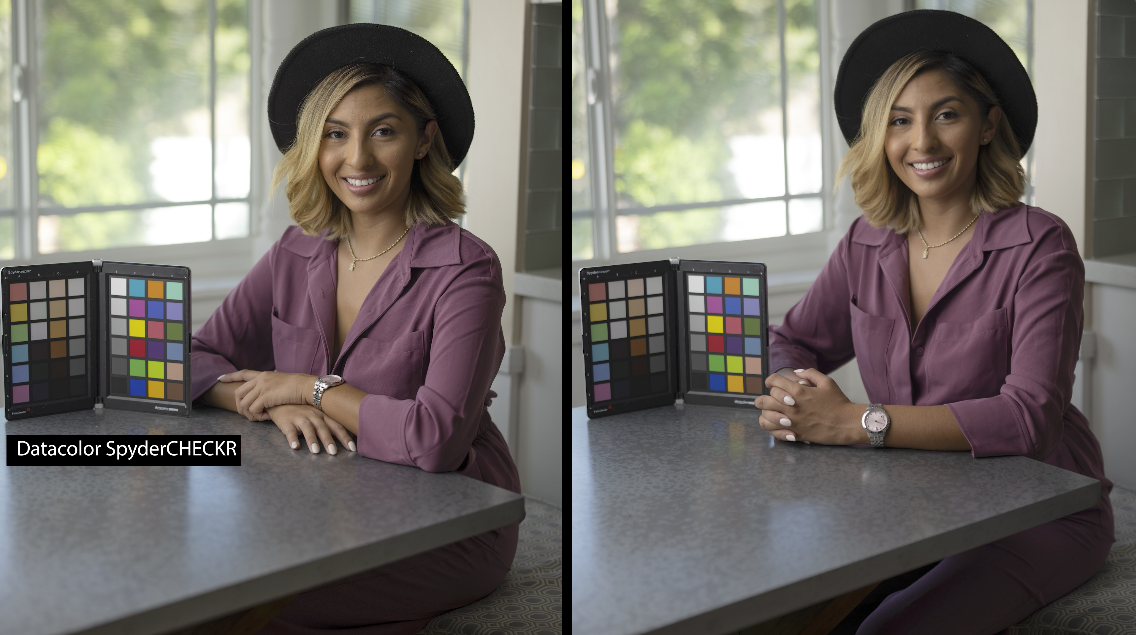 Here’s our first image This is properly exposed.
Here’s our first image This is properly exposed. 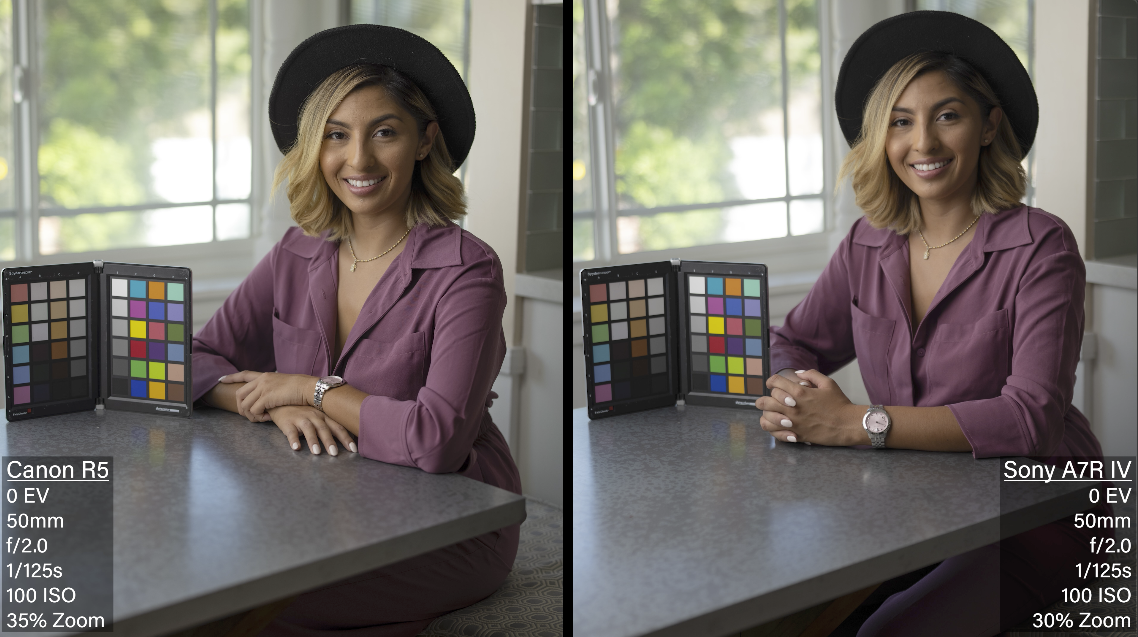 So only some minor adjustments here, tried to open up a little bit of the shadows and bring the highlights within range as much as possible. There are things in the background that are totally blown out. That’s a white truck out there, which is getting the broad sun on it. It has no detail regardless. I think I could have opened up the Sony shadows a little bit more looking at it now. That’s a minor adjustment in post.
So only some minor adjustments here, tried to open up a little bit of the shadows and bring the highlights within range as much as possible. There are things in the background that are totally blown out. That’s a white truck out there, which is getting the broad sun on it. It has no detail regardless. I think I could have opened up the Sony shadows a little bit more looking at it now. That’s a minor adjustment in post.
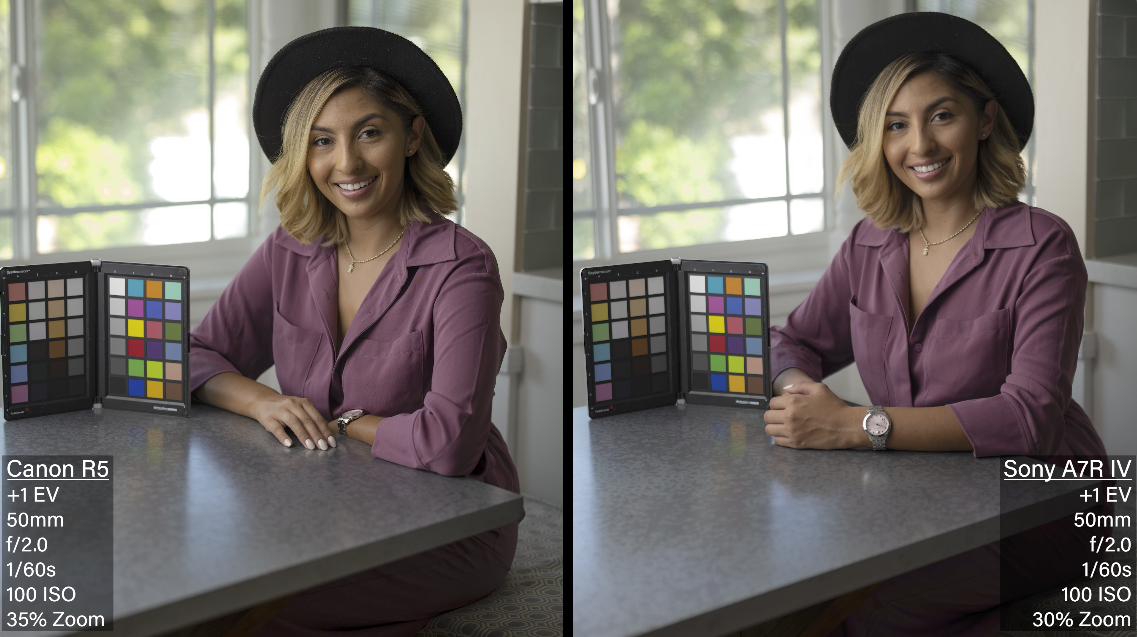 And then if we go plus one stop. Overexposure is where the digital cameras always struggle. But plus one stop shouldn’t be too much of a sweat. And both these cameras are just fine.
And then if we go plus one stop. Overexposure is where the digital cameras always struggle. But plus one stop shouldn’t be too much of a sweat. And both these cameras are just fine.
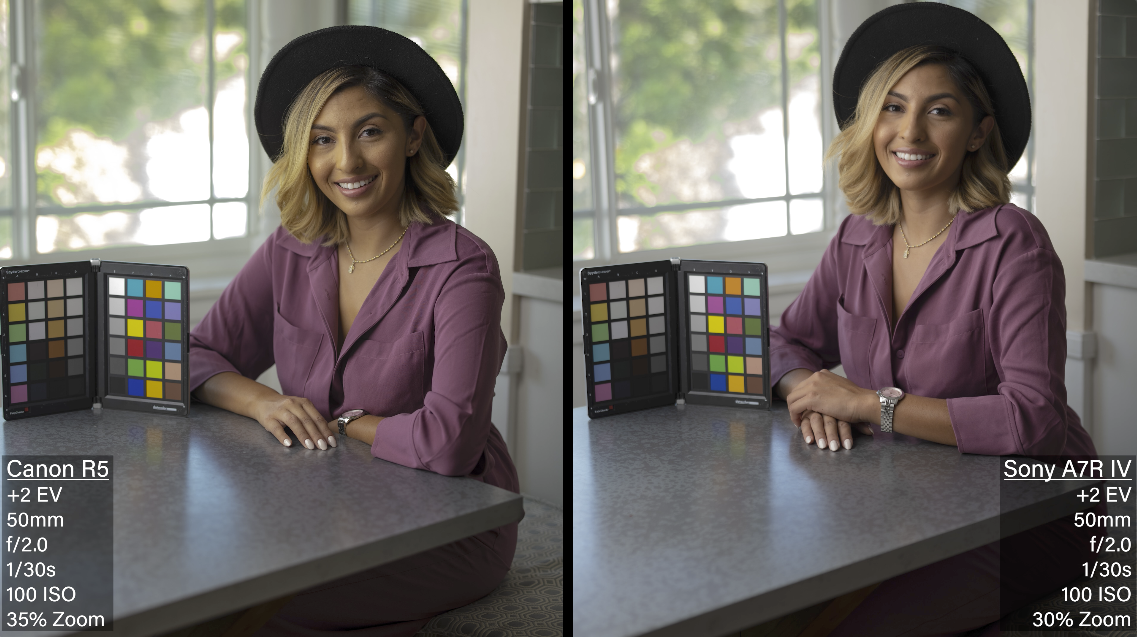 Here we are at two plus stops. Look at this Sony. It is holding the background, when we’re getting that posterization with the Canon on the left. We get all that white out there. Her skin too is yellow with the Canon.
Here we are at two plus stops. Look at this Sony. It is holding the background, when we’re getting that posterization with the Canon on the left. We get all that white out there. Her skin too is yellow with the Canon.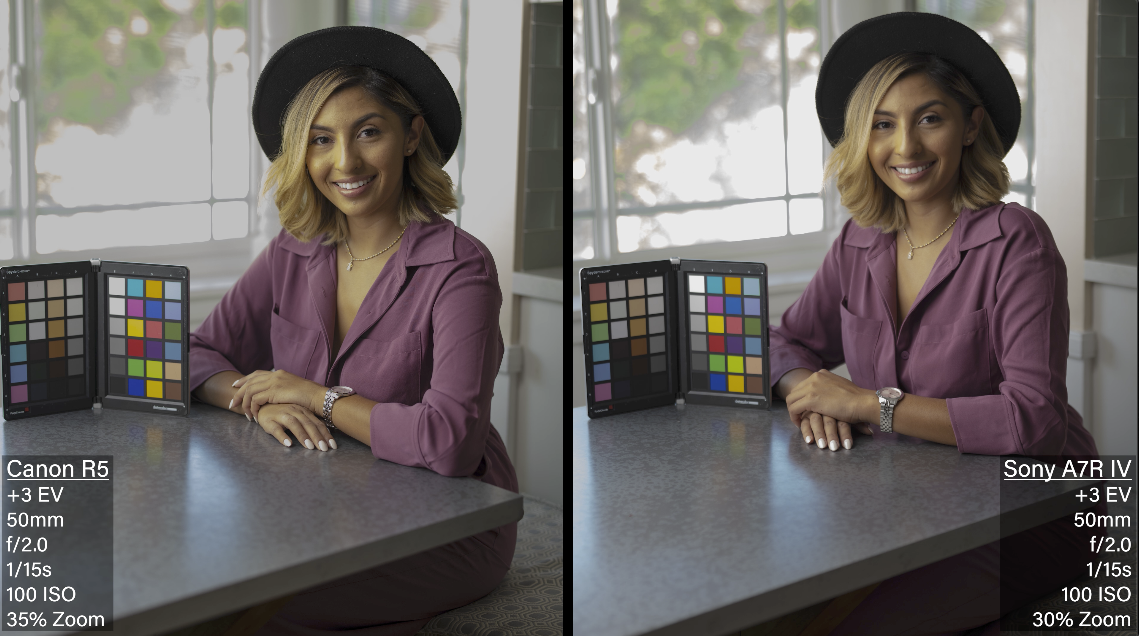
Then we go to plus three. Both cameras are starting to lose skin tone. We have clipping on her nose. Canon is a little worse.
Under exposure is where digital cameras usually shine because you’re preserving highlight detail a little more, and then you can lift up the shadows. It’s kind of the opposite of the way film used to work.
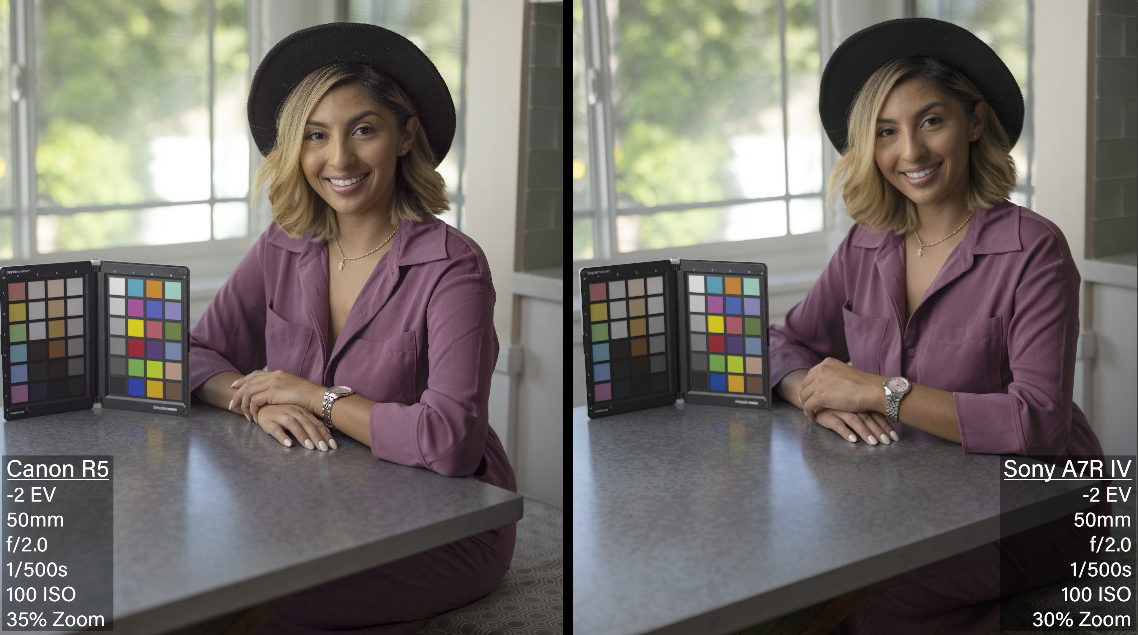 Here we have minus two stops. They both look really nice. You could probably blow these up large.
Here we have minus two stops. They both look really nice. You could probably blow these up large.
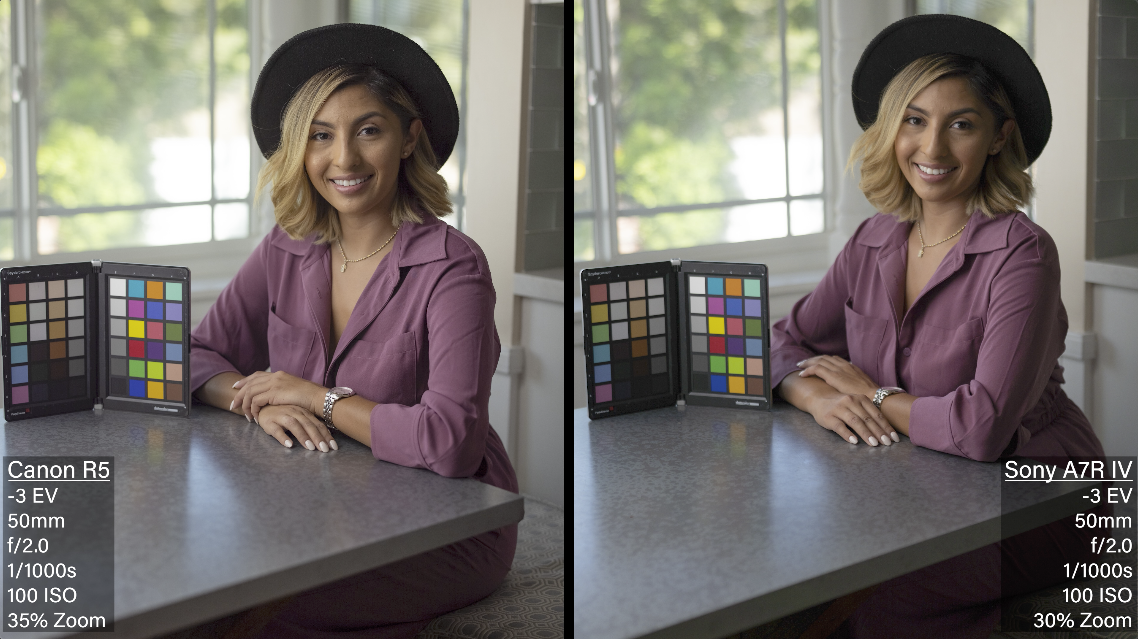
Moving into minus three stops. This is where many cameras start to struggle. And they both look pretty fine to me. They are still holding the highlights in the background.
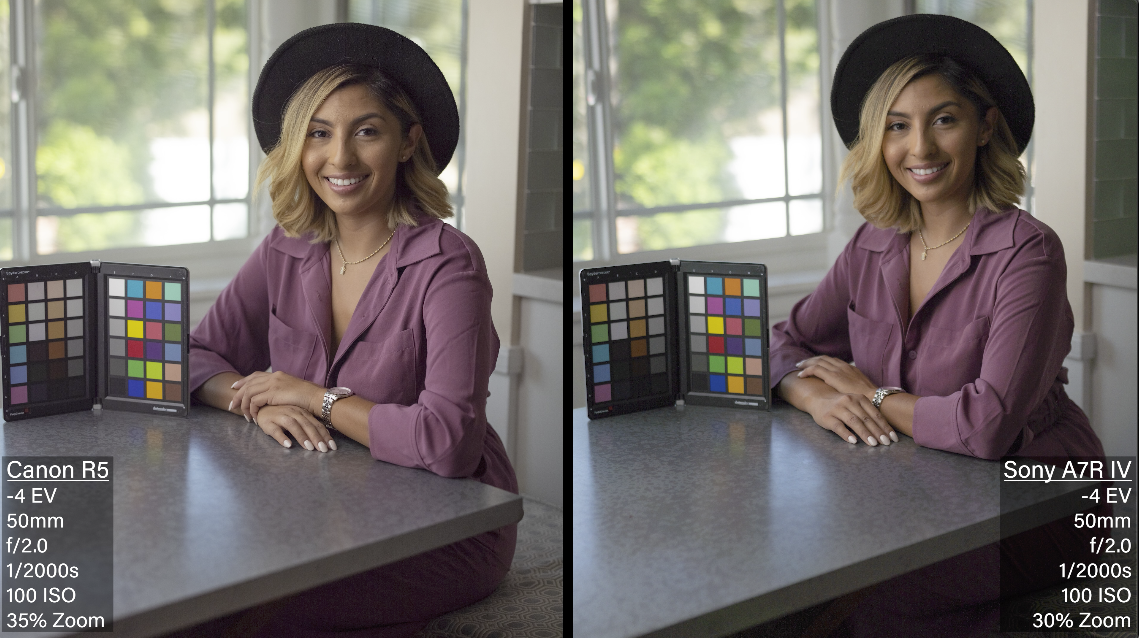
Here we look at minus four stops. We are starting to see the Sony is slowing down a little bit. It’s getting darker as we try and bring up the details more.
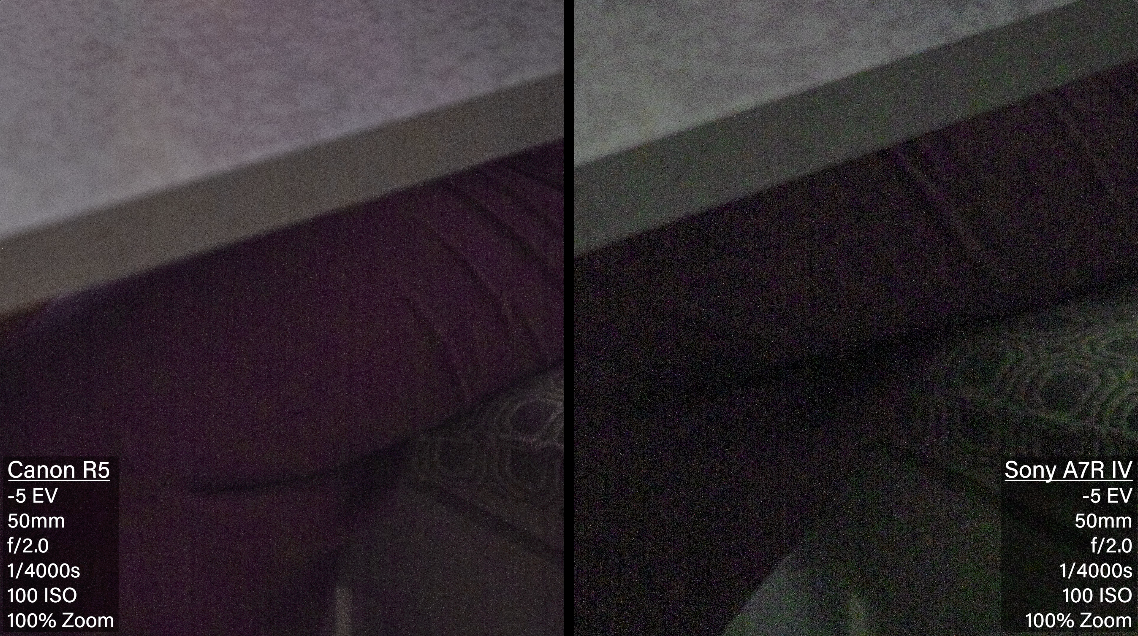
Look under the table, it’s starting to be lost a little bit. But the color for both of them is holding really well.
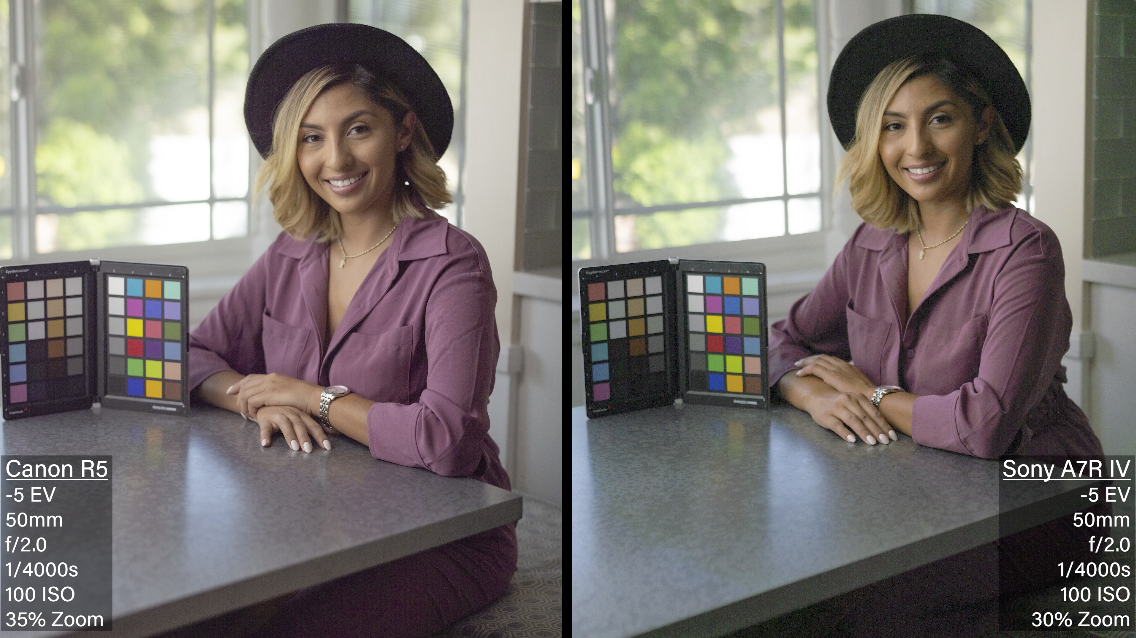 At minus five stops I’m definitely seeing some shift in the image within the SpyderCheckr on the Canon. It really kind of has a magenta or warm cast.
At minus five stops I’m definitely seeing some shift in the image within the SpyderCheckr on the Canon. It really kind of has a magenta or warm cast.
Look at the SypderCheckr for the Sony. It’s still pretty vivid. It looks pretty good. But if you look at her skin it is going green. I guess minus five is where both these cameras kind of tap out.
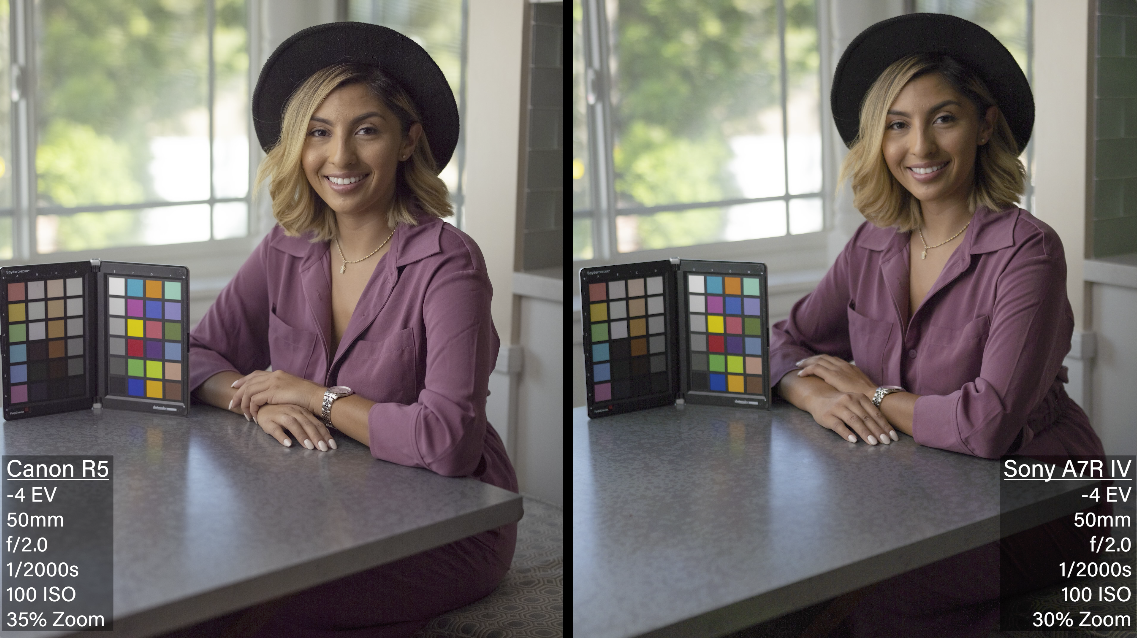
Well, look at the amount of digital noise in the shadows on the Sony in comparison. Which surprised me because it’s a larger file. There should be more information there. I would have expected that more with the Canon. Canon is usually pretty good at under exposure. 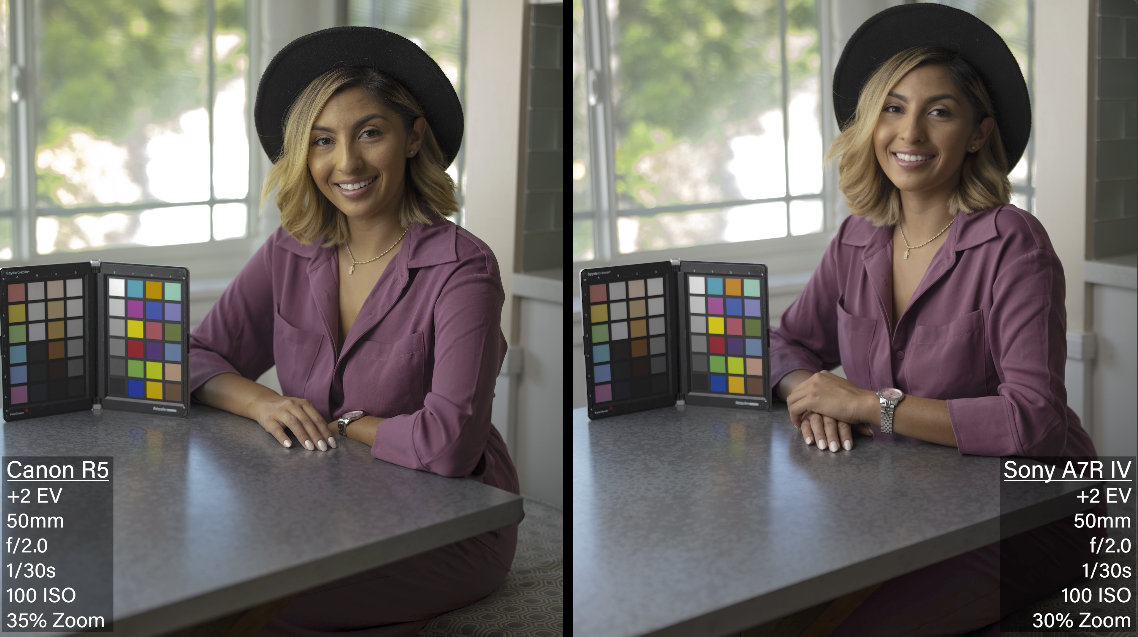 But you also have to keep in mind the Canon was a little brighter to begin with. So even at minus four stops the Canon is like a third of a stop brighter. In under exposure it looks like the Canon might have a slight edge in overexposure. The Sony has a slight edge so it comes out in the wash.
But you also have to keep in mind the Canon was a little brighter to begin with. So even at minus four stops the Canon is like a third of a stop brighter. In under exposure it looks like the Canon might have a slight edge in overexposure. The Sony has a slight edge so it comes out in the wash.
If an old seasoned photographer were to give you any advice for digital photography, it would be “Underexpose my child, underexpose.”
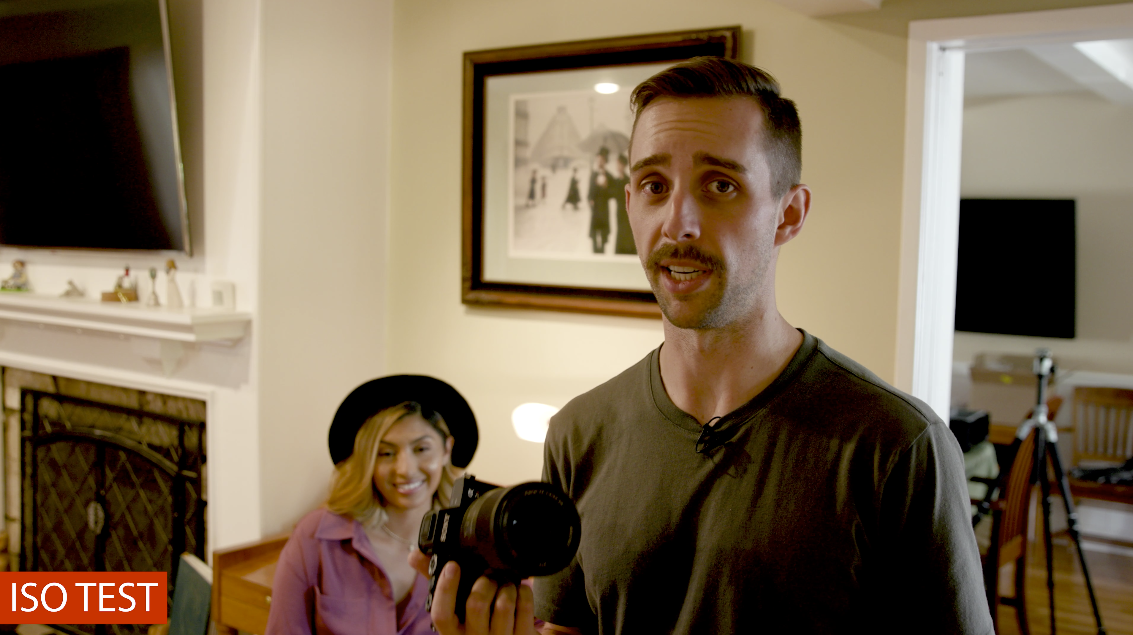
We’re setting up for the ISO test right now. We have a Datacolor SpyderCheckr chart that we’re going to use. It’s a bit of a mixed lighting scenario. You’ll be able to see how the different colors react. The Sony goes up to 32,000 ISO and the Canon goes up to 51,200. I don’t think it really matters which one goes higher. Who ever shoots that high anyway?
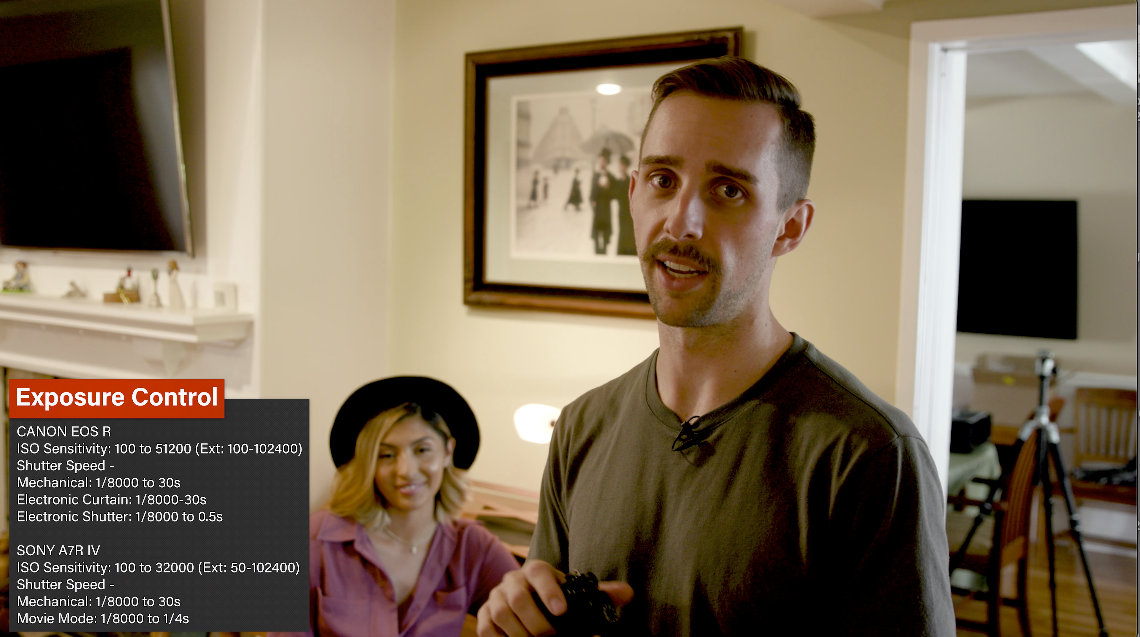
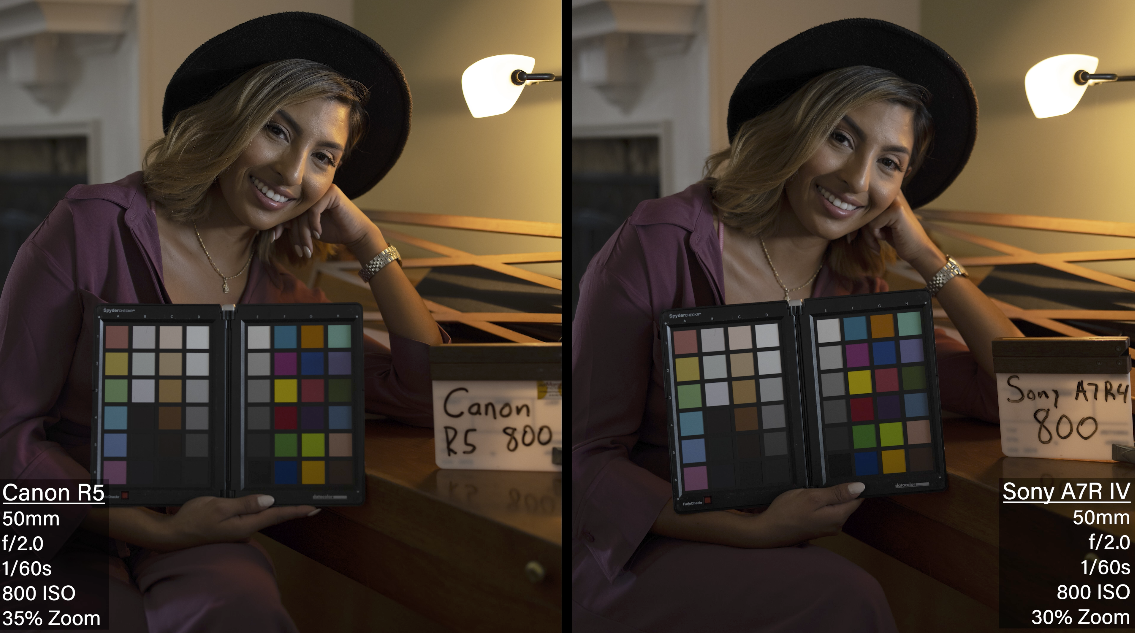 Let’s look at 800 ISO. We usually start there because there wasn’t a lot of light in the room. Plus, most of these cameras look pretty clean up to 800 ISO. It looks beautiful.
Let’s look at 800 ISO. We usually start there because there wasn’t a lot of light in the room. Plus, most of these cameras look pretty clean up to 800 ISO. It looks beautiful.
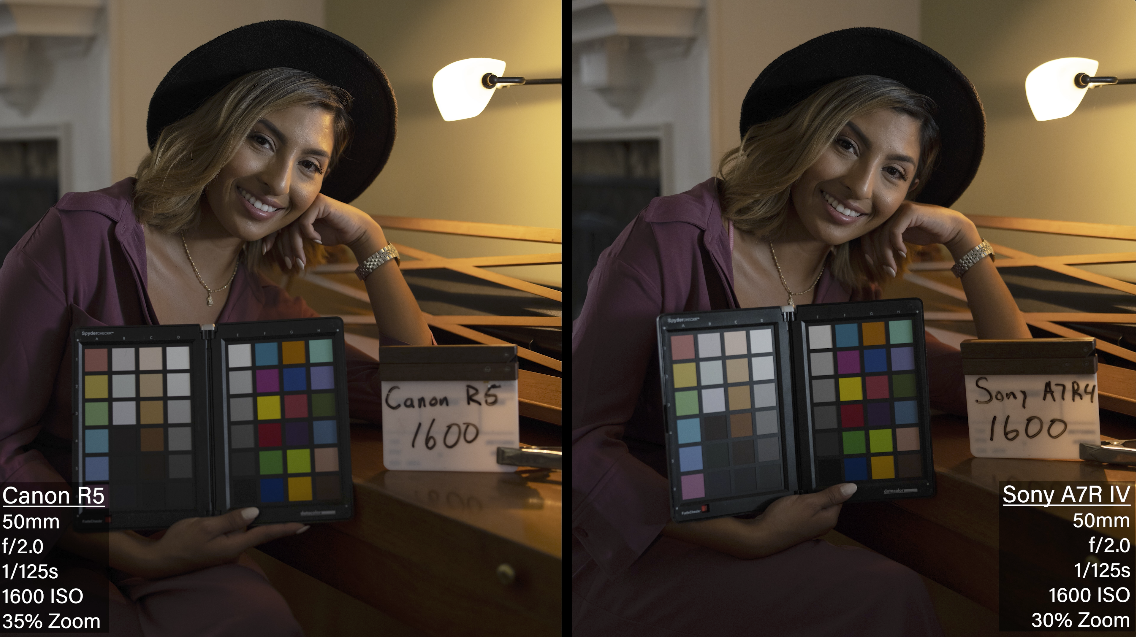
Here we are at 1600 ISO. I would start to expect noise here. But I’m not getting a lot. I mean, you see a little bit of texture in the darker parts of her skin. But it’s really not much.

At 3200 ISO it still looks really beautiful. If you blow it up, you do start to see a little bit of texture. It gets a little gritty. There is a little more with the Sony. 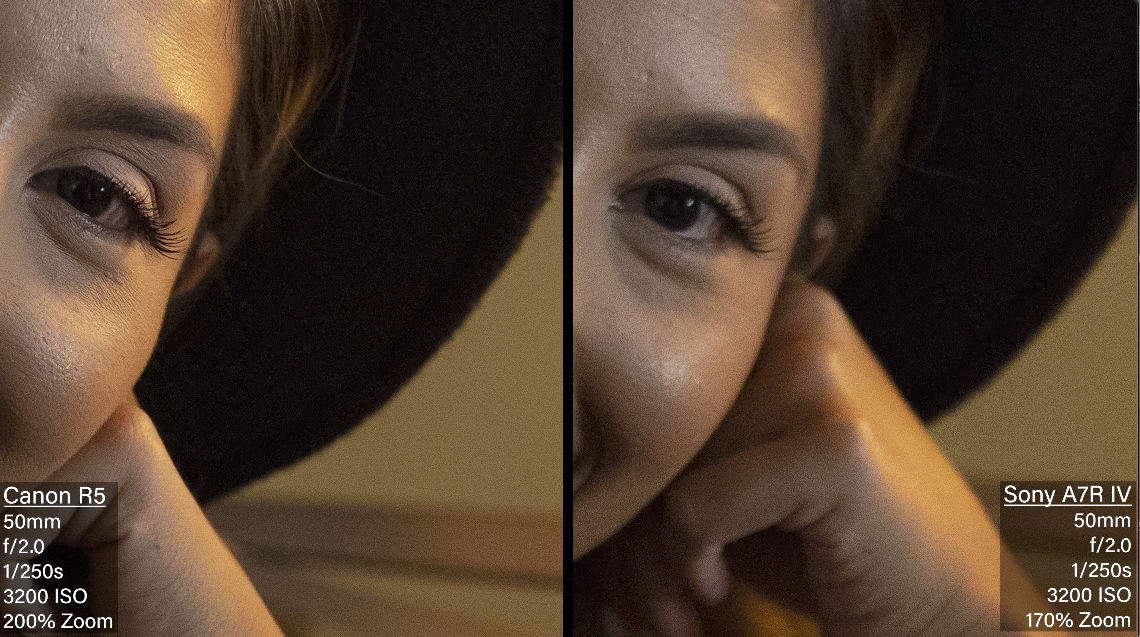 I’m seeing the grain building a little more with the Sony at 3200 than with the Canon.
I’m seeing the grain building a little more with the Sony at 3200 than with the Canon.
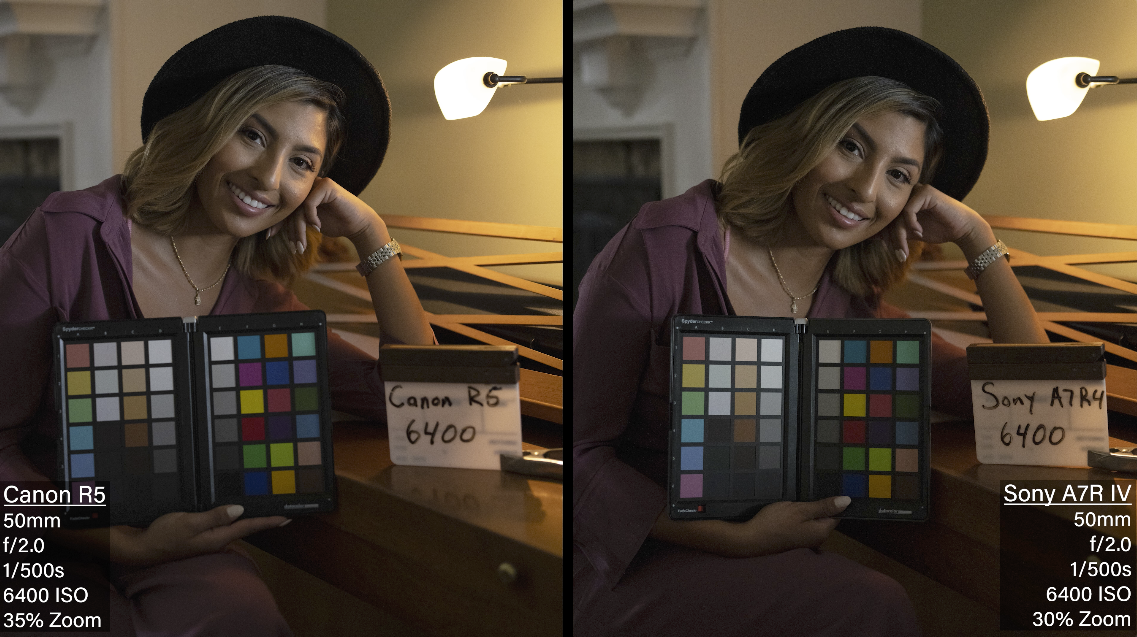
Here is 6400 ISO. You can see the Sony starting to build the grain quicker. At 6400 you’re definitely seeing the Sony is a little more grainy. You start to see some red blocks starting to show up a little bit as well. 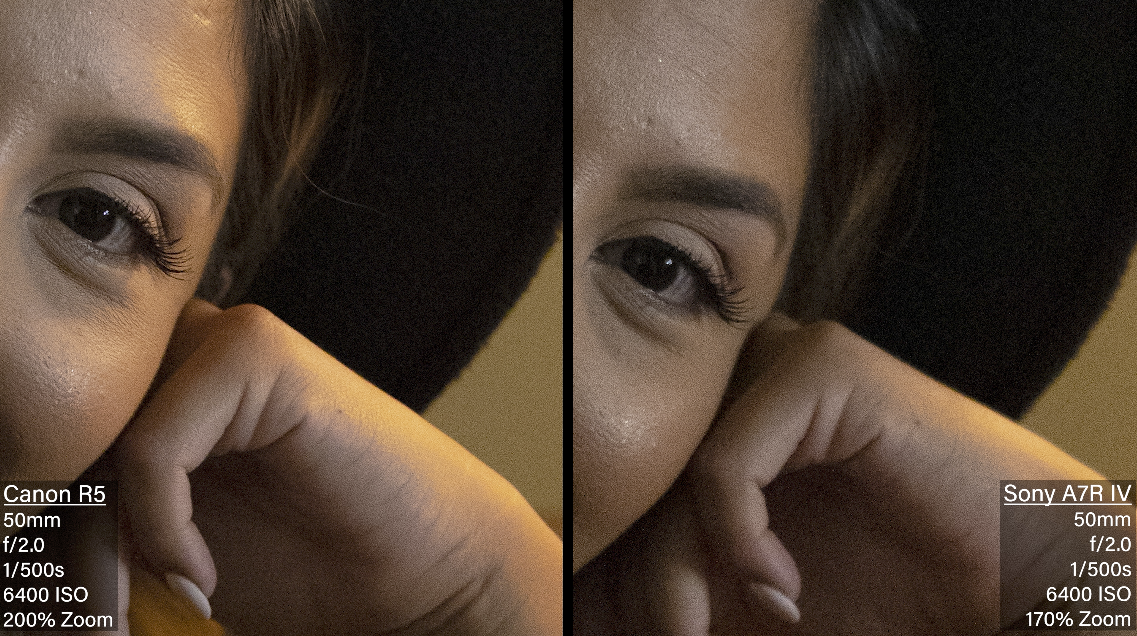 To be honest though, you can shoot either of these the 6400 and print an 8 x 10 easy. In fact, I would even say if we go to 12,800, you could probably print this as an 8 x 10, which is mind blowing.
To be honest though, you can shoot either of these the 6400 and print an 8 x 10 easy. In fact, I would even say if we go to 12,800, you could probably print this as an 8 x 10, which is mind blowing.
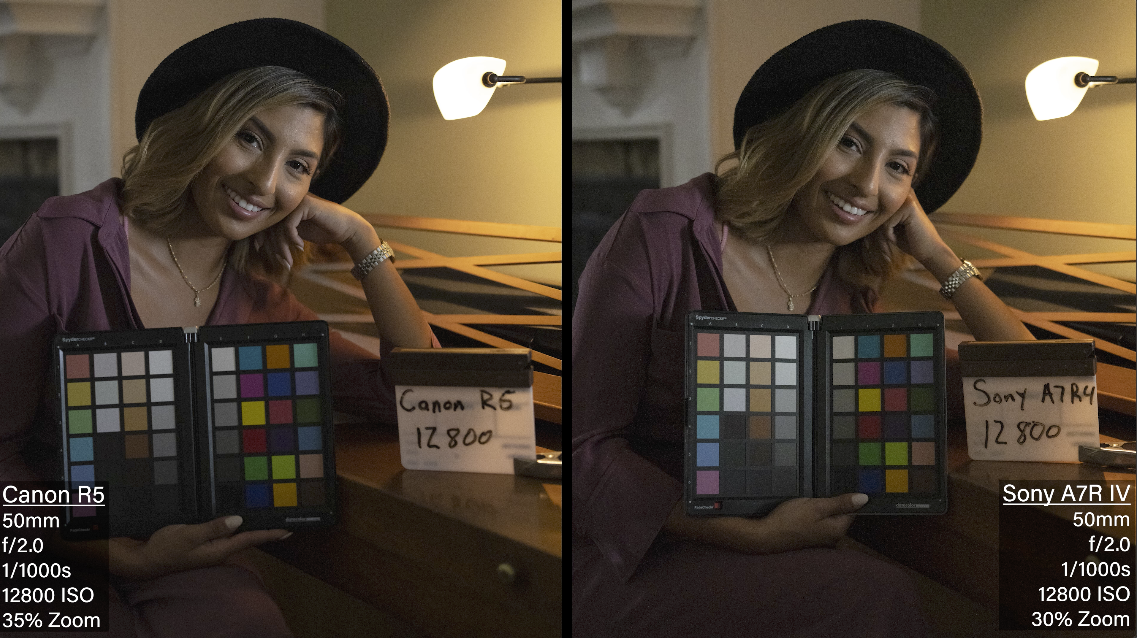
Let’s look at 25,600 ISO. This is the highest the Sony goes. And there’s a reason why, because it’s starting to look terrible. The Canon looks consistent. It’s definitely noisy now. 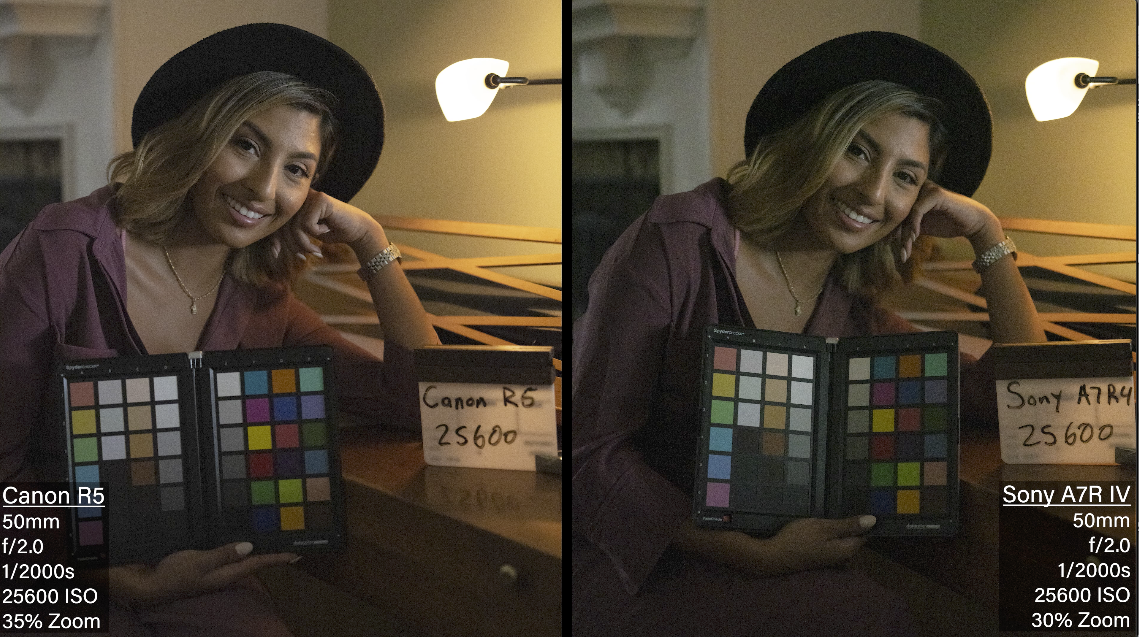 I don’t know that I would ever shoot this high. But the colors are consistent, the brightness is consistent, which is saying something. I think I might lean towards a Canon if I were planning to shoot really low light situations that required a high ISO. But I would still hope I never have to shoot past 6400 ISO.
I don’t know that I would ever shoot this high. But the colors are consistent, the brightness is consistent, which is saying something. I think I might lean towards a Canon if I were planning to shoot really low light situations that required a high ISO. But I would still hope I never have to shoot past 6400 ISO.
So what’s our conclusion here now that we’ve spent all day with these cameras? I expected there to be a clear winner here. In my mind, I expected to walk away going yeah, this is definitely the camera. I feel like they are head to head. They really are. What’s your sense?
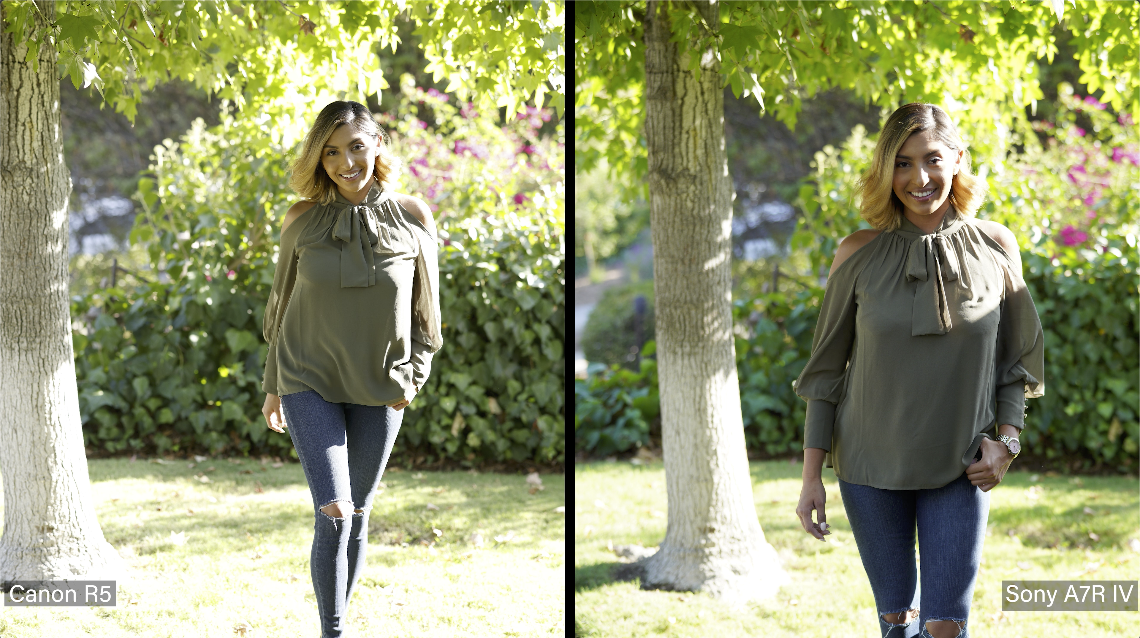
Who’s this camera made for? Looking back at the tests, they both are very good in autofocus. Canon might have a slight advantage with autofocus. I think they are the same with dynamic range. Both are very good in low light, though Canon might have a slight edge. Just a little bit.
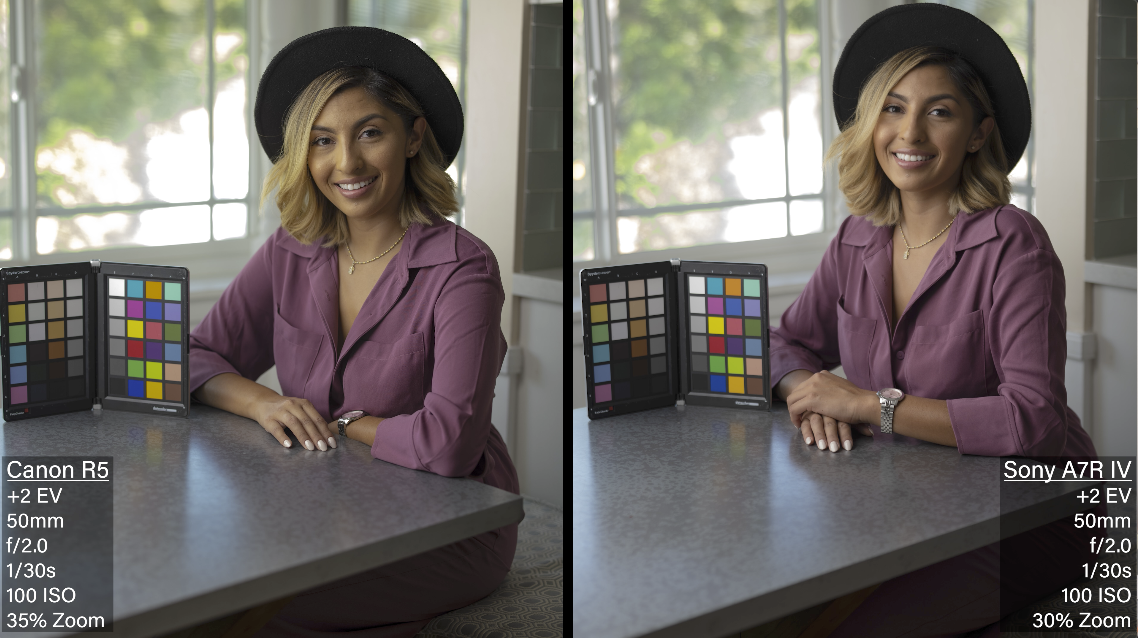
And just taking pictures, they both look amazing. So there are a couple categories where the Canon has a little bit of an edge. It also shoots a higher frame rate. It has less of a buffer thing going on. It has more autofocus points. So I would actually say if you have to pick a winner, I think Canon is the winner.
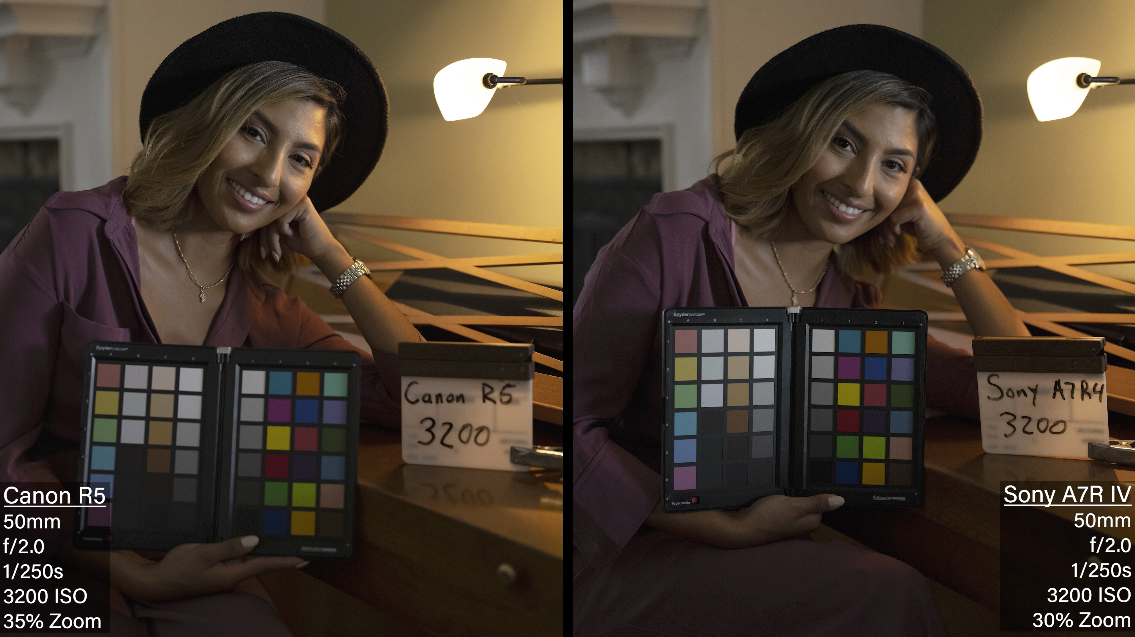
These are the newest, most expensive cameras on the market. And I would say the Canon is probably the best full frame stills camera we’ve ever shot with. I think the Sony is like 99% there. The fact that it’s still competing with Canon’s latest offering might say something about Canon. Canon is still trying to get caught up. 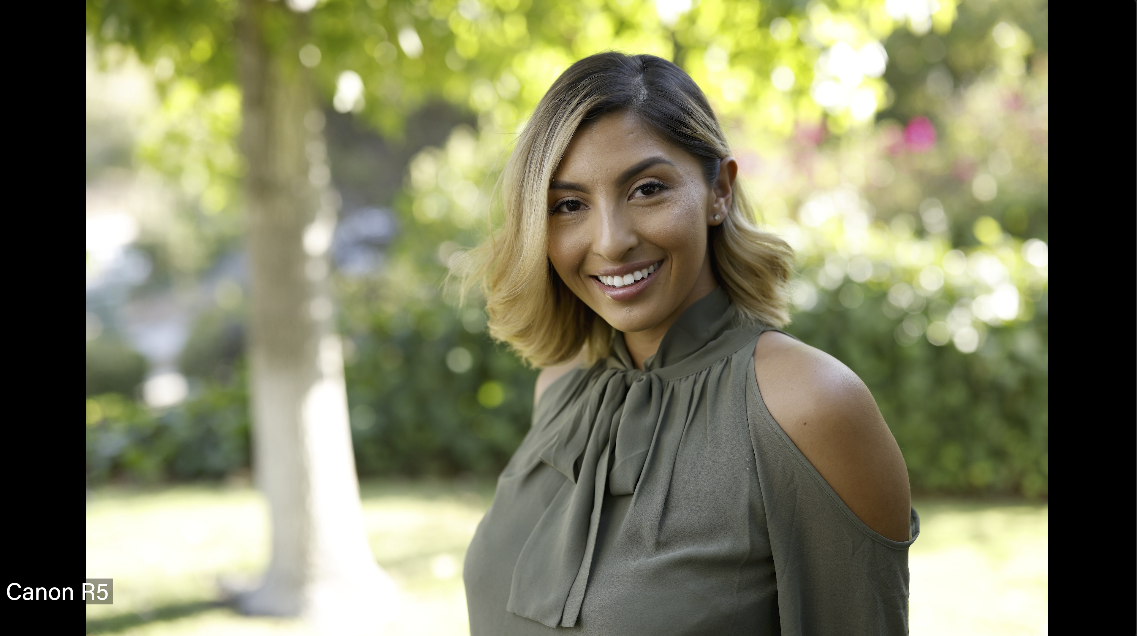 But I just want to say that for now the Canon R5 may be the best camera out there. It’s an amazing stills camera, a really great tool. But it does bring us back to your question of who are they for? There are people who should probably buy the Sony. if I was an a73 owner and I wanted to step my camera up and I had lenses, there’s not enough compelling evidence here to make you switch to Canon or vice versa. You know, there just isn’t.
But I just want to say that for now the Canon R5 may be the best camera out there. It’s an amazing stills camera, a really great tool. But it does bring us back to your question of who are they for? There are people who should probably buy the Sony. if I was an a73 owner and I wanted to step my camera up and I had lenses, there’s not enough compelling evidence here to make you switch to Canon or vice versa. You know, there just isn’t. 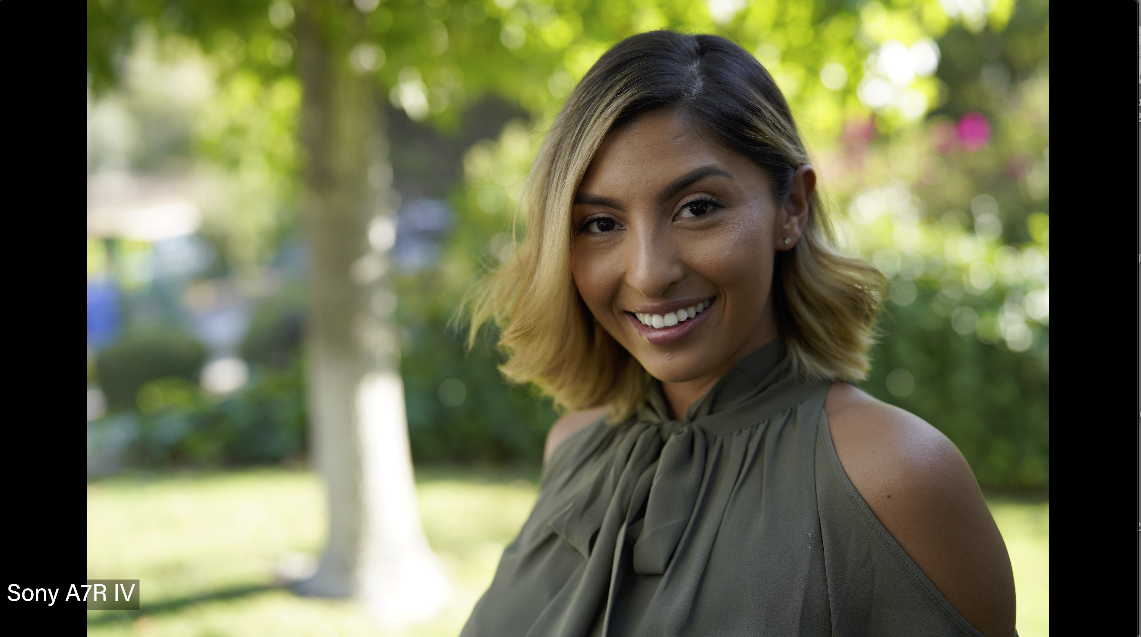 If you’re an EOS R owner, and you’re thinking about stepping up and you’re thinking, you know what, I don’t have any RF glass. Then you might want to decide which glass you want to invest in. Because if you’re going to have to buy all new RF glass, then you have to decide which of these platforms is best for you.
If you’re an EOS R owner, and you’re thinking about stepping up and you’re thinking, you know what, I don’t have any RF glass. Then you might want to decide which glass you want to invest in. Because if you’re going to have to buy all new RF glass, then you have to decide which of these platforms is best for you. 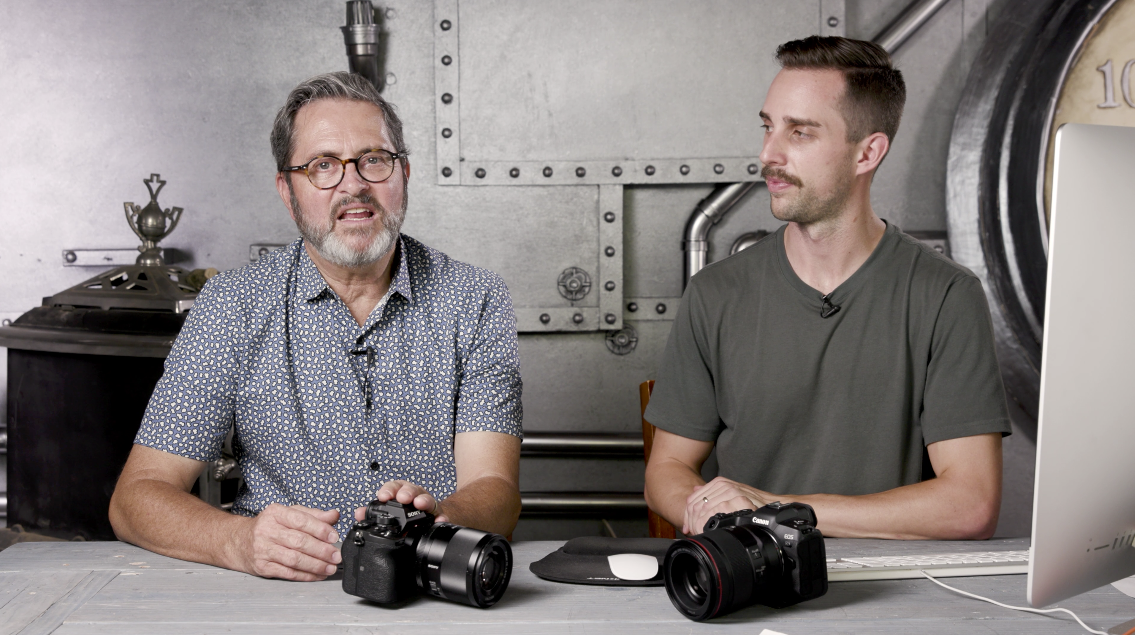 And that brings on a whole other conversation about glass. So the glass is a big deal because there isn’t a lot of RF glass. It’s all very expensive, and there aren’t third party options right now. Sony has a ton of third party options.
And that brings on a whole other conversation about glass. So the glass is a big deal because there isn’t a lot of RF glass. It’s all very expensive, and there aren’t third party options right now. Sony has a ton of third party options.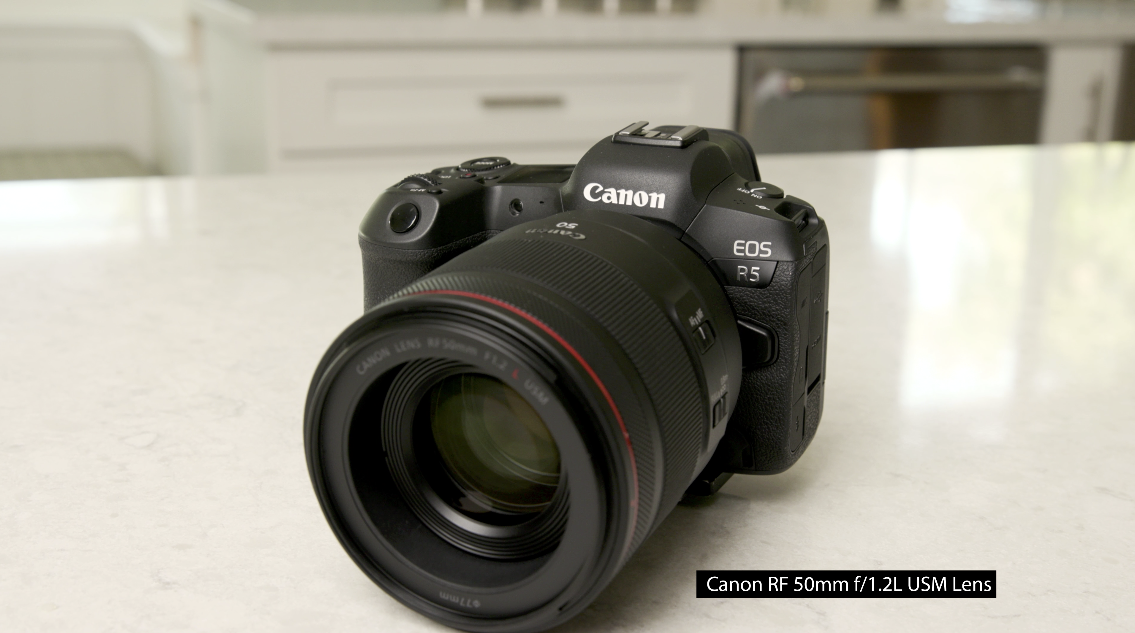
Sony has Tamron and Sigma. They have some great options out there. 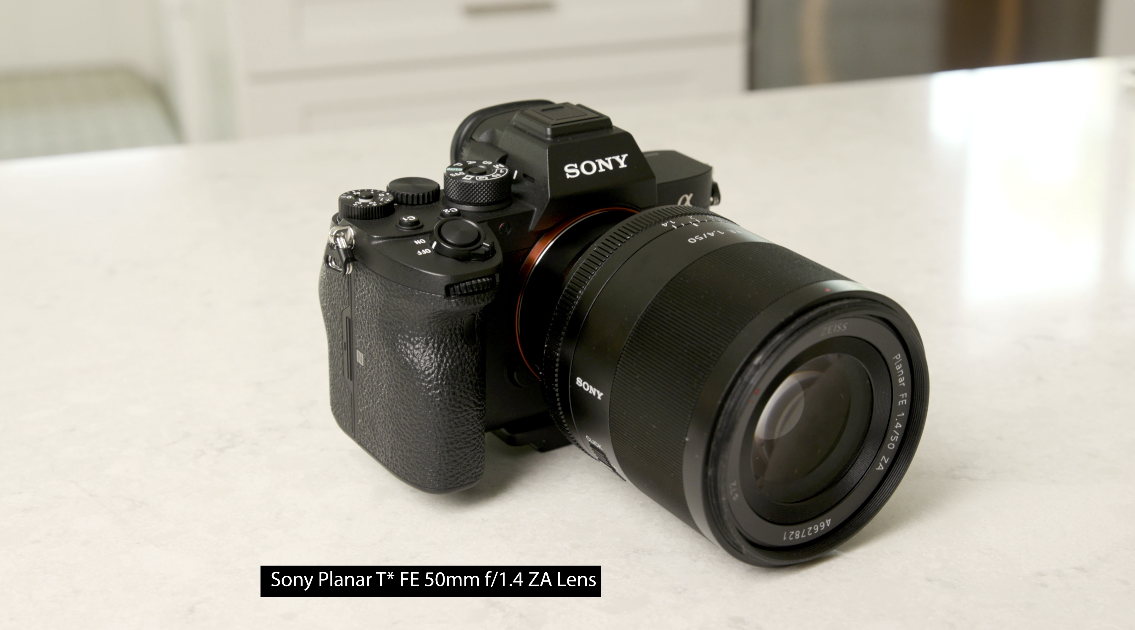 If you’re a landscape photographer and you’re really into as much information as possible, I think the Sony might be a great decision for you. Because you’re going to get these beautiful large images. You can stitch them together to make them larger and get very high resolution photos with a lot of information there. As we’ve done format comparisons that option really makes this camera dang close to a medium format. It really is the closest thing out there to the quality and the detail and the resolution of a medium format camera.
If you’re a landscape photographer and you’re really into as much information as possible, I think the Sony might be a great decision for you. Because you’re going to get these beautiful large images. You can stitch them together to make them larger and get very high resolution photos with a lot of information there. As we’ve done format comparisons that option really makes this camera dang close to a medium format. It really is the closest thing out there to the quality and the detail and the resolution of a medium format camera.
If you shoot video as well I think the Sony is a clear winner. We have talked about the video features before versus some other video cameras and the Canon just totally blew it. They blew it with video. I think that the Sony would be a better investment for that kind of stuff.
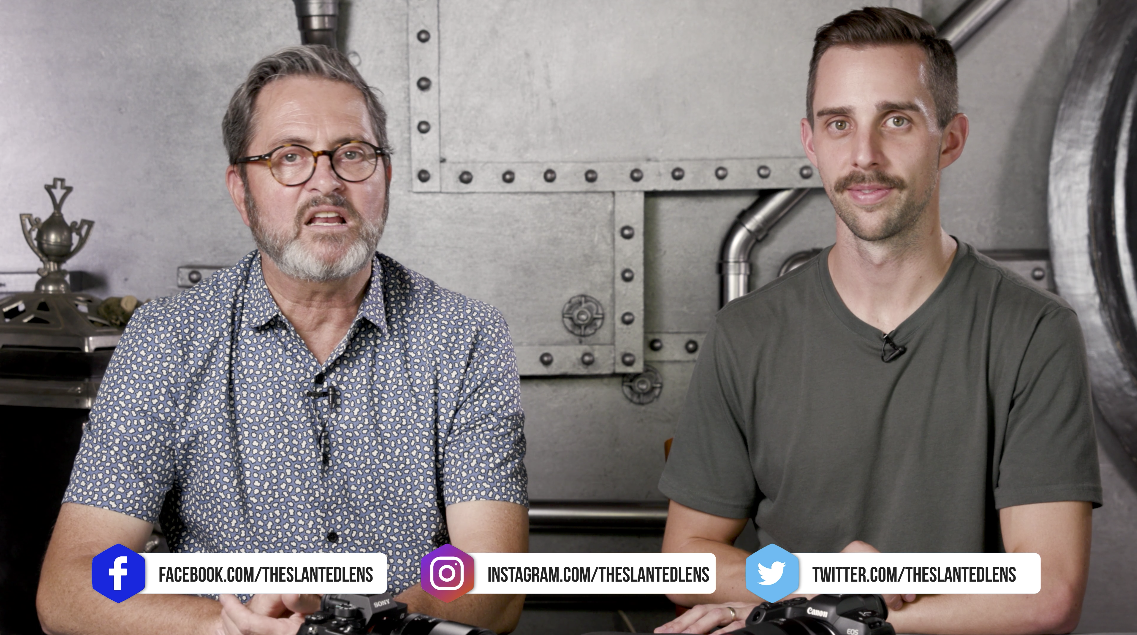
Alright, so there you have it. There’s a look at these two cameras head to head. They are two great cameras that really are the two heavy hitters in the market right now. We’re retty excited about the thought of Nikon getting into this with the next offering that they’re bringing. Nikon has the new Z7 Mark II. It should jump right into this category right here and compete extremely well. I love Nikon’s great looking picture. There’s a company that really focuses on still photography and cameras. They’re not trying to knock everyone out of the arena in the video market. So all right. Leave us some comments on our YouTube channel. Let us know what you think. Make sure you subscribe to YouTube.com/TheSlantedLens. Then ring that bell so you get a notification when we have new lessons. We appreciate your support! So keep those cameras rollin’ and keep on clickin’.
Take a look at the Kinotehnik 802 Light Panel.
